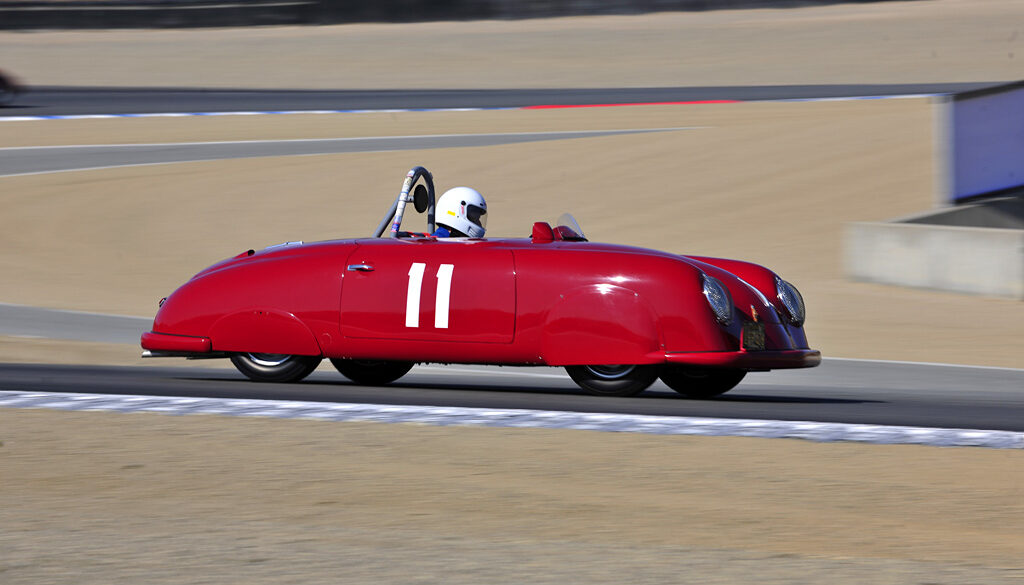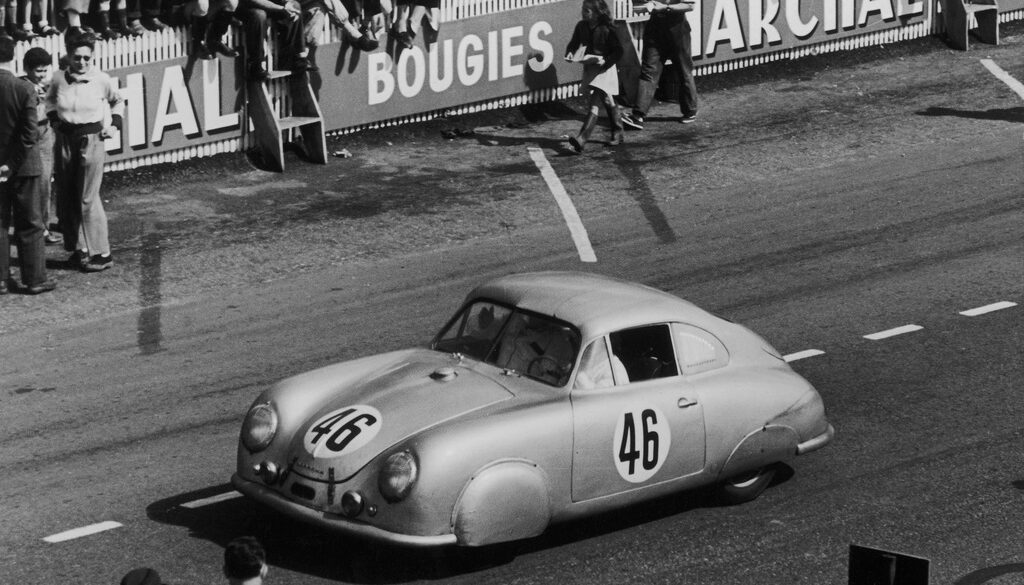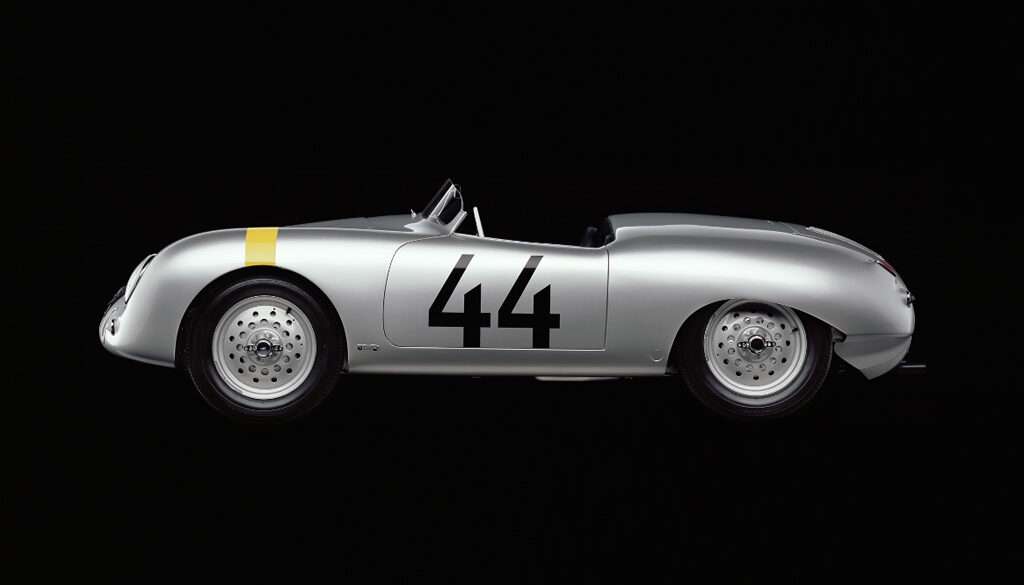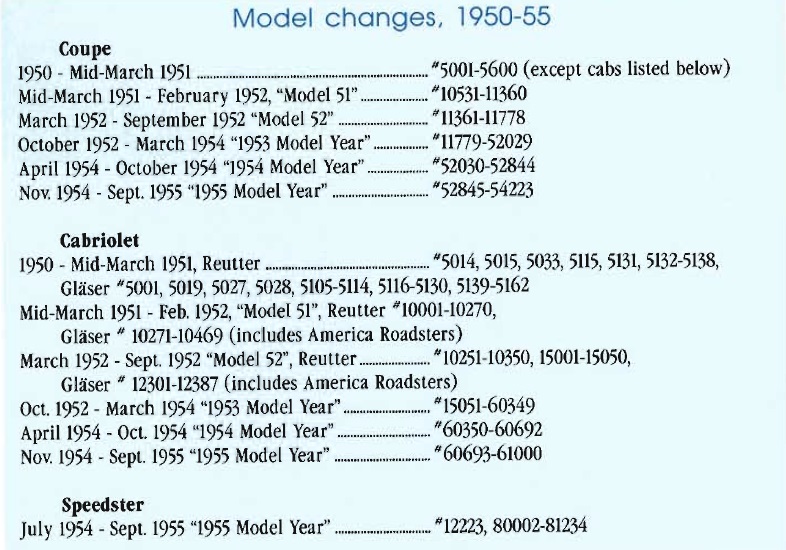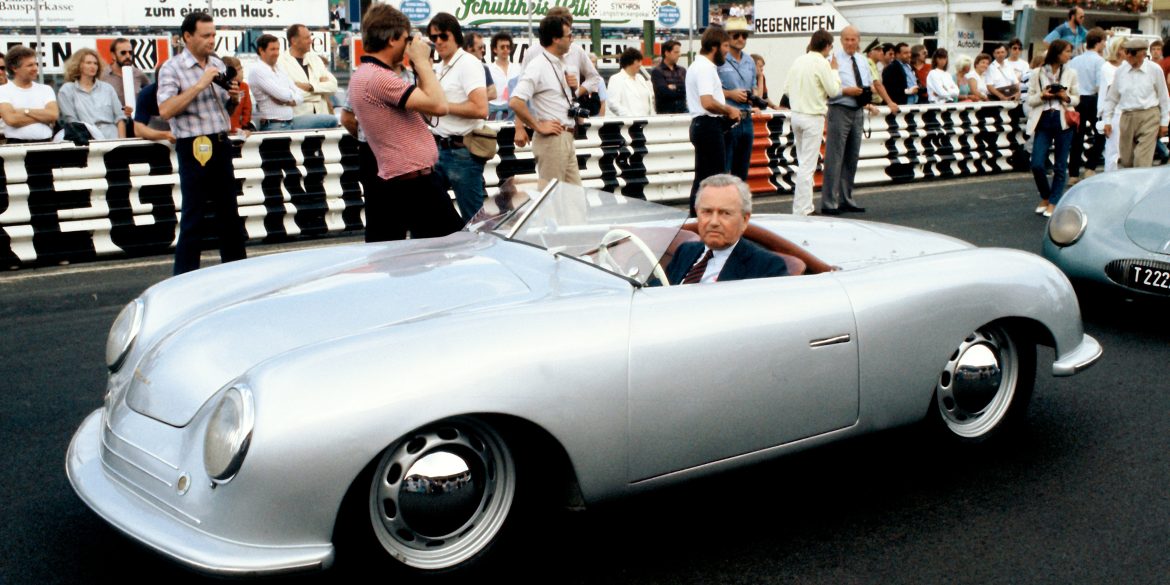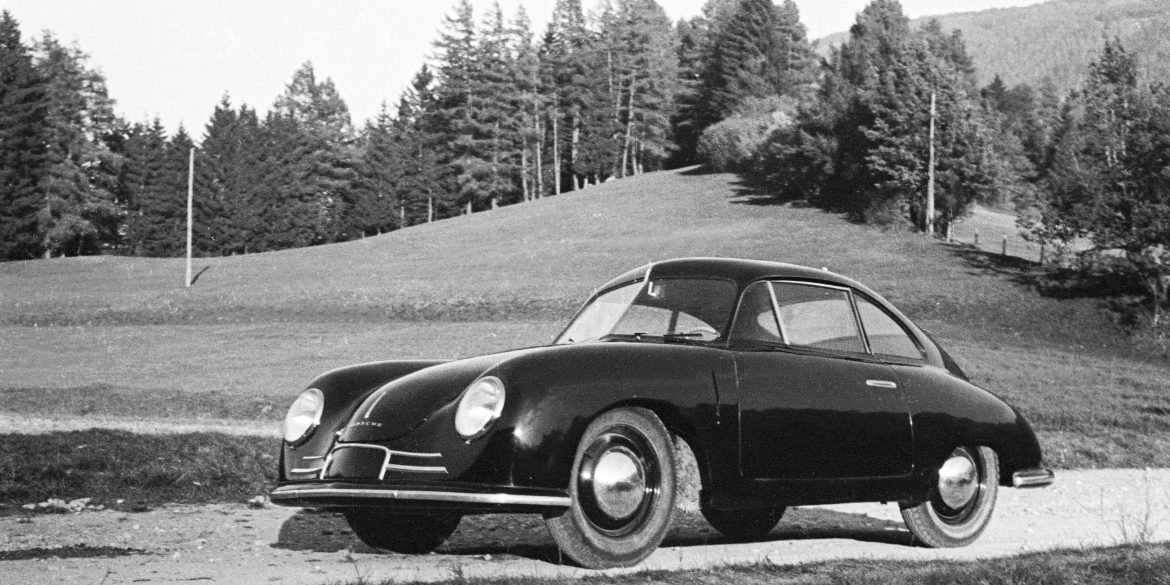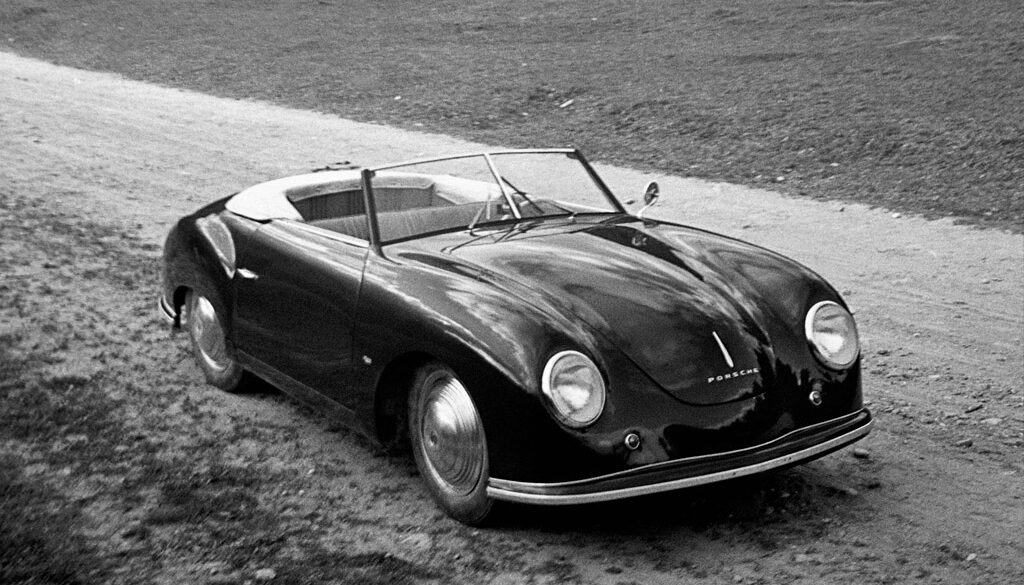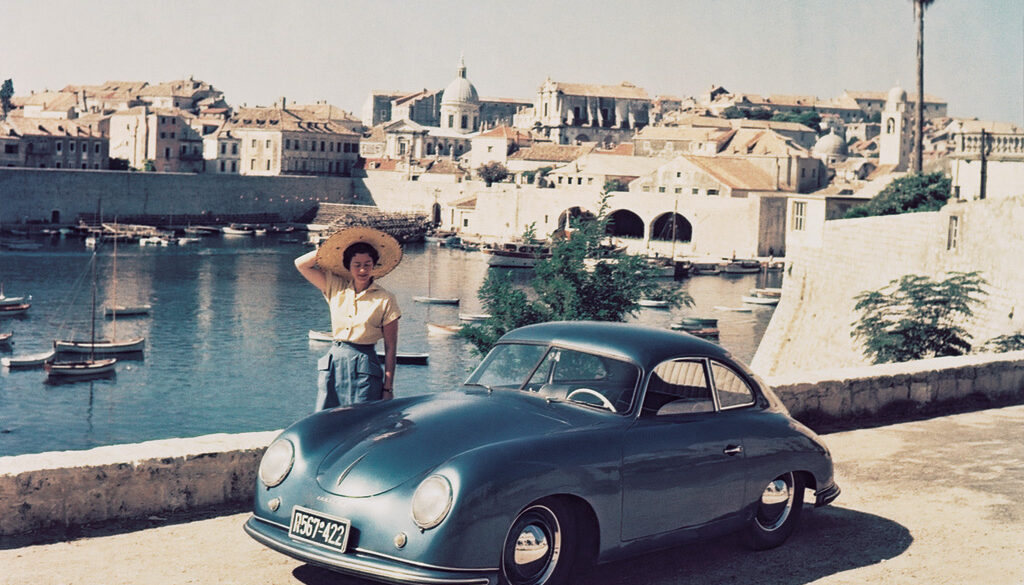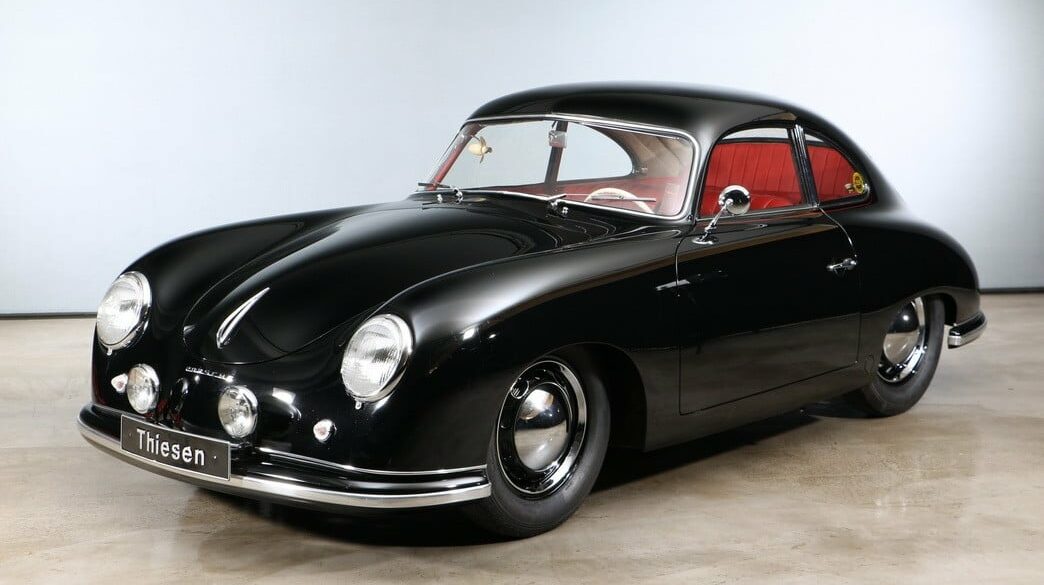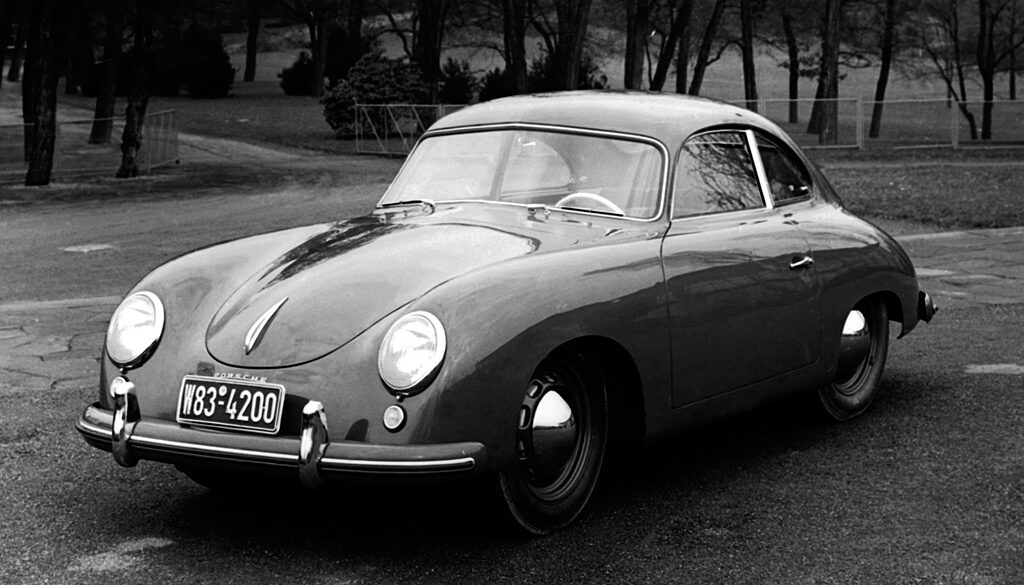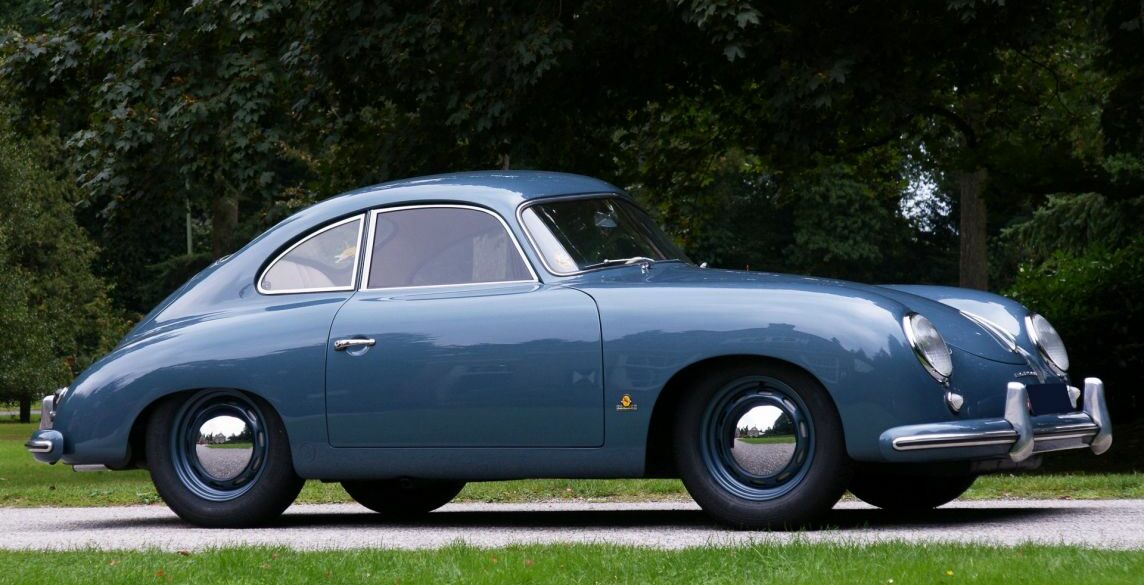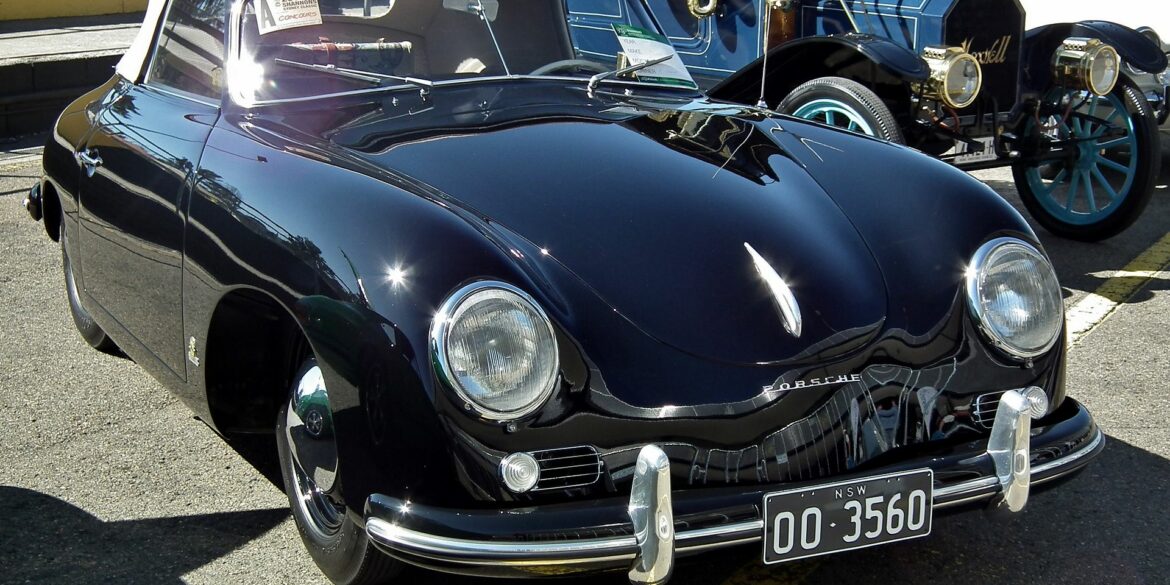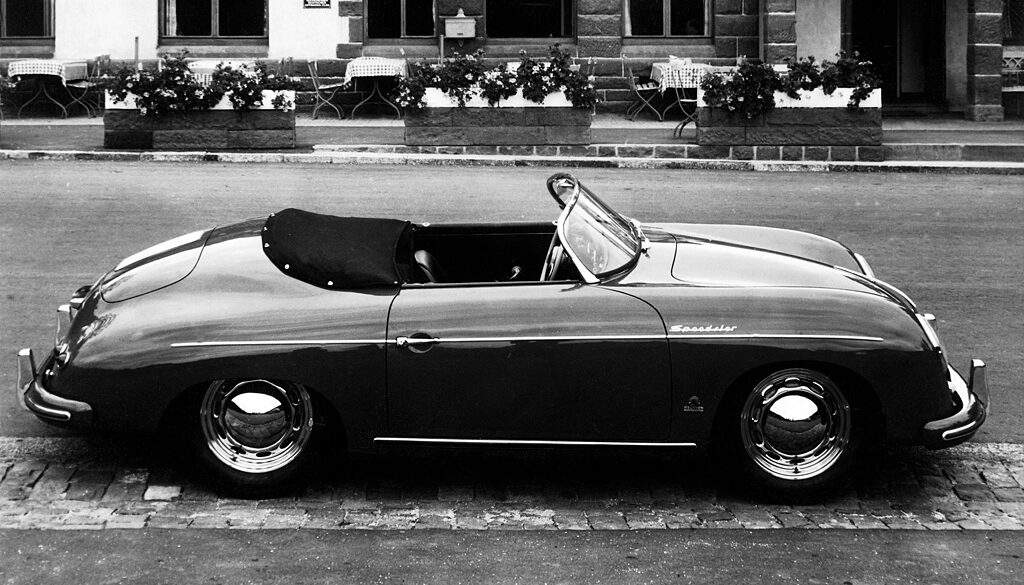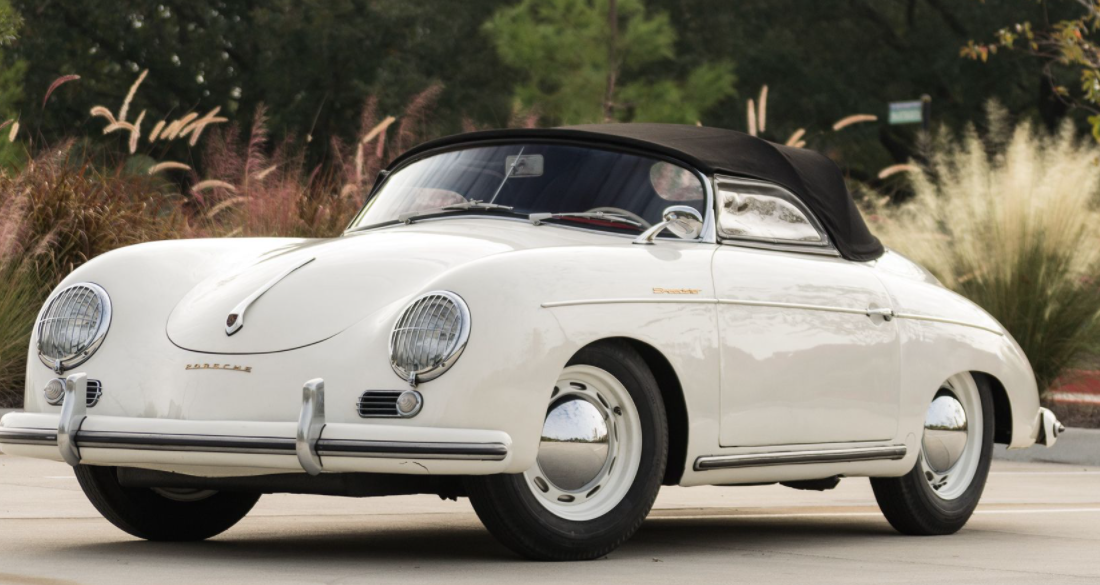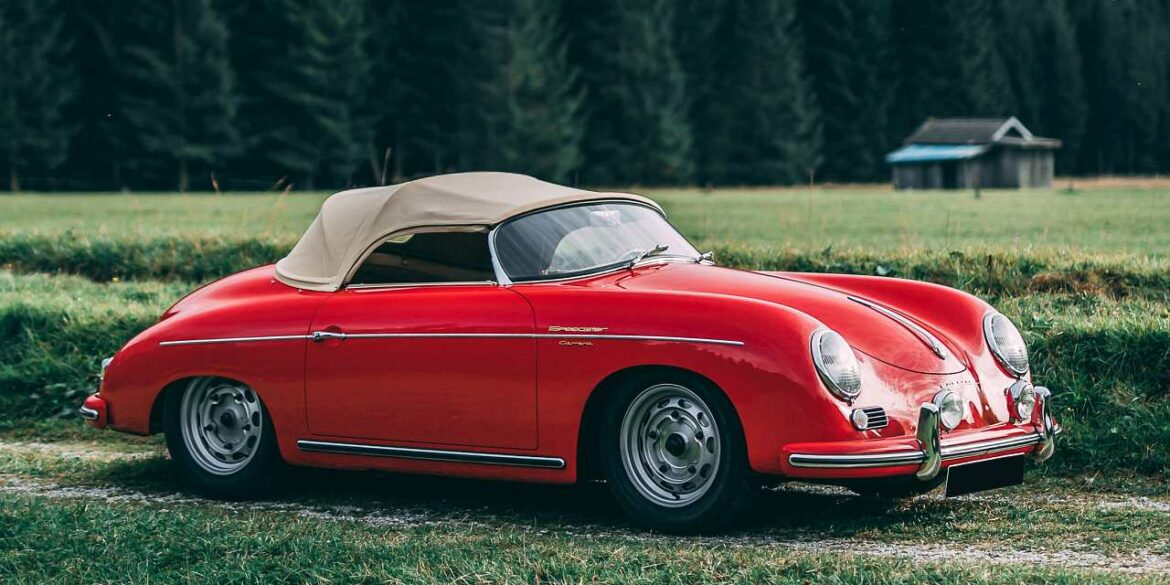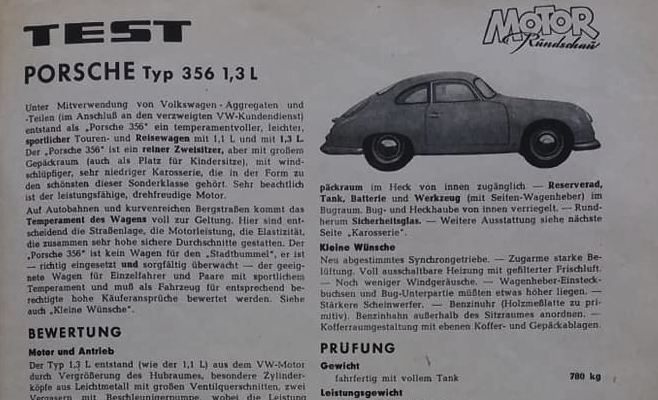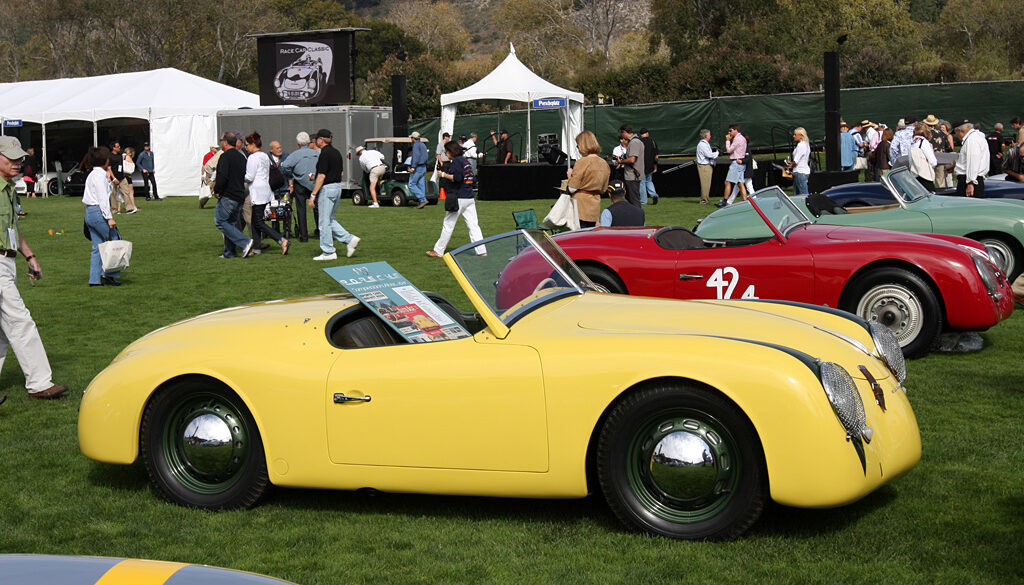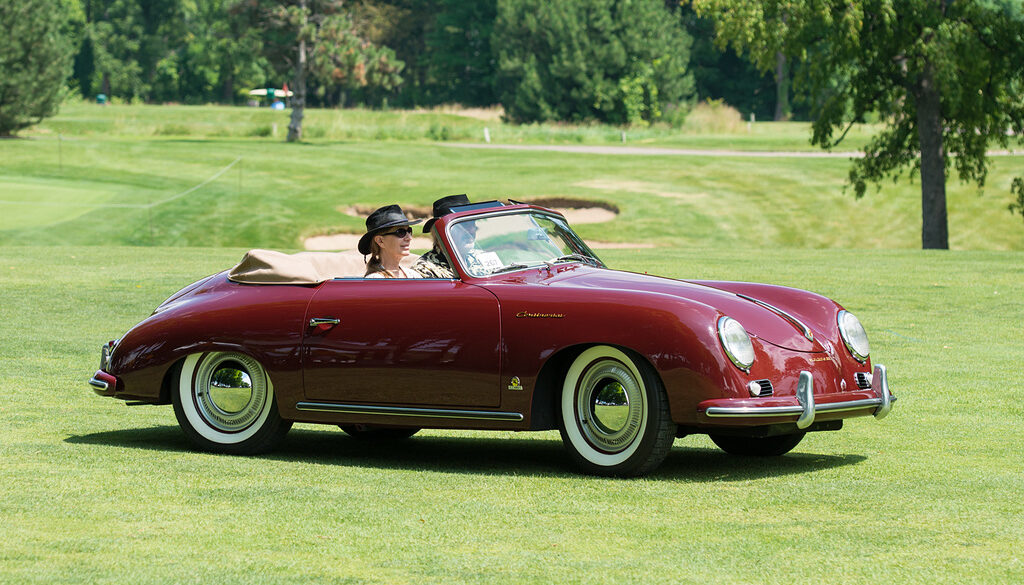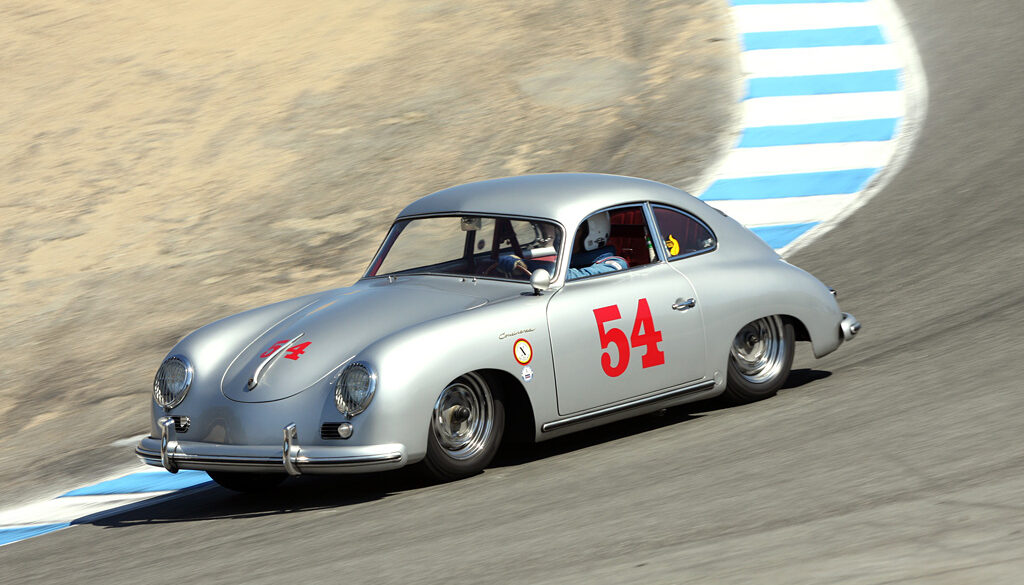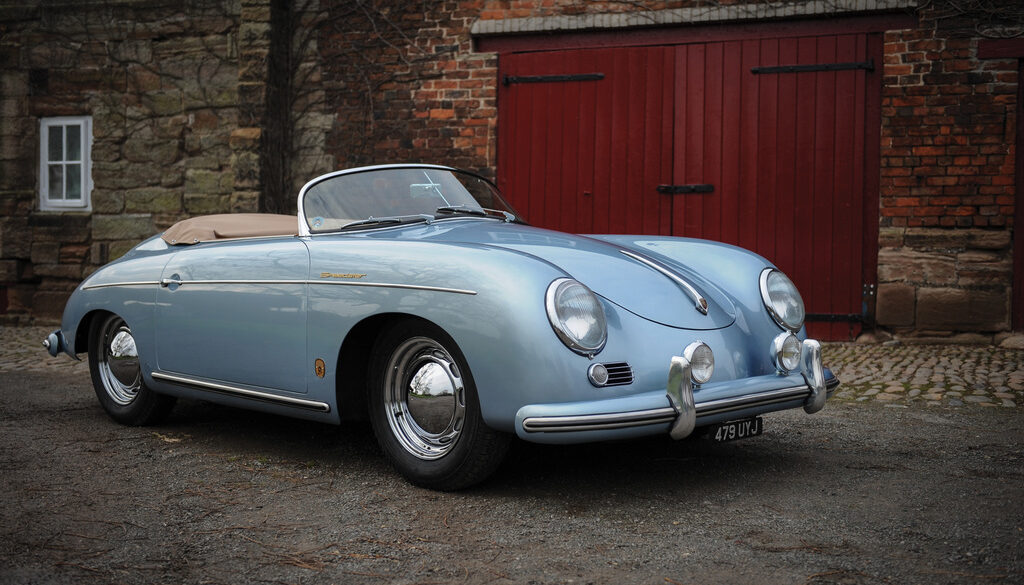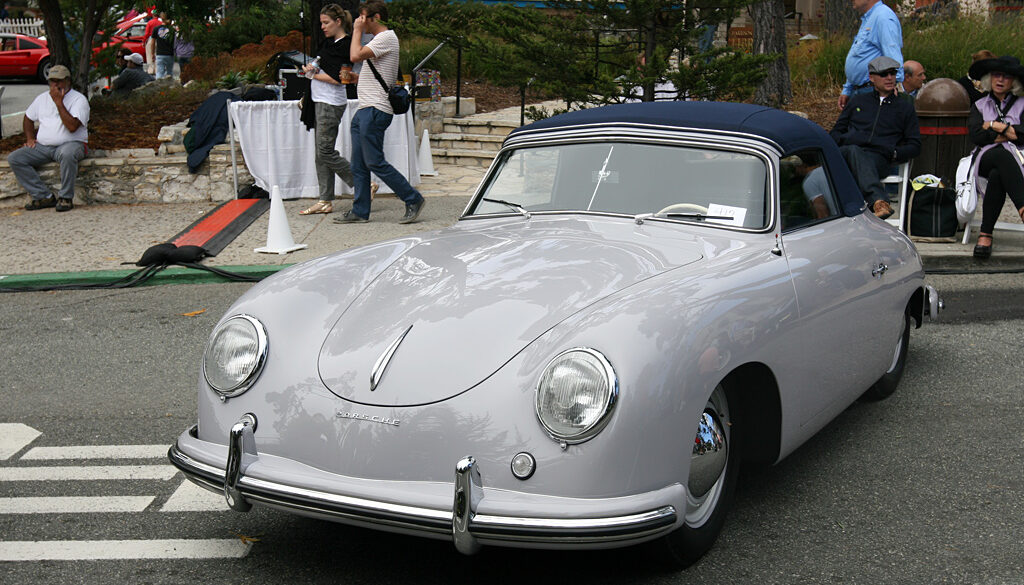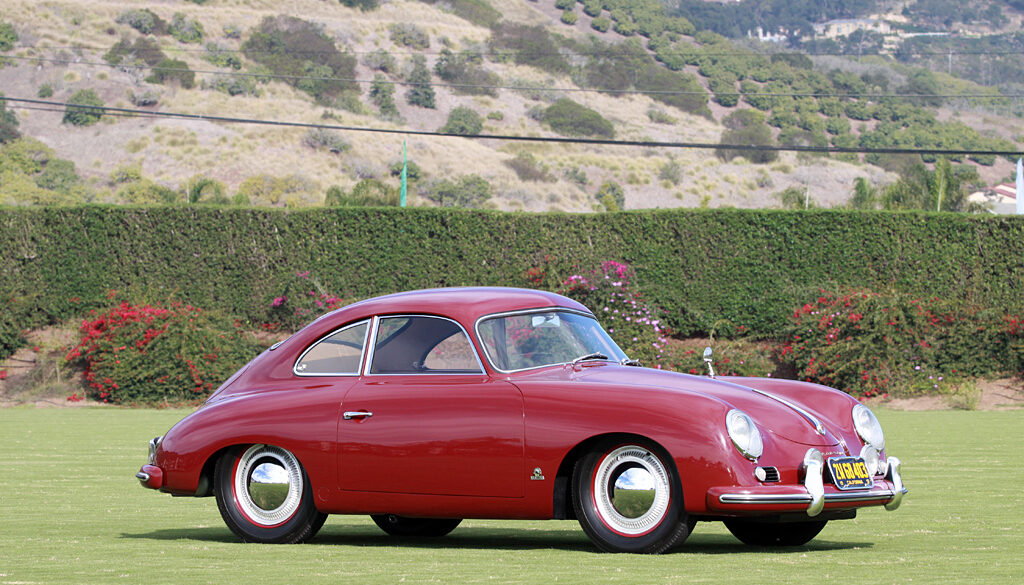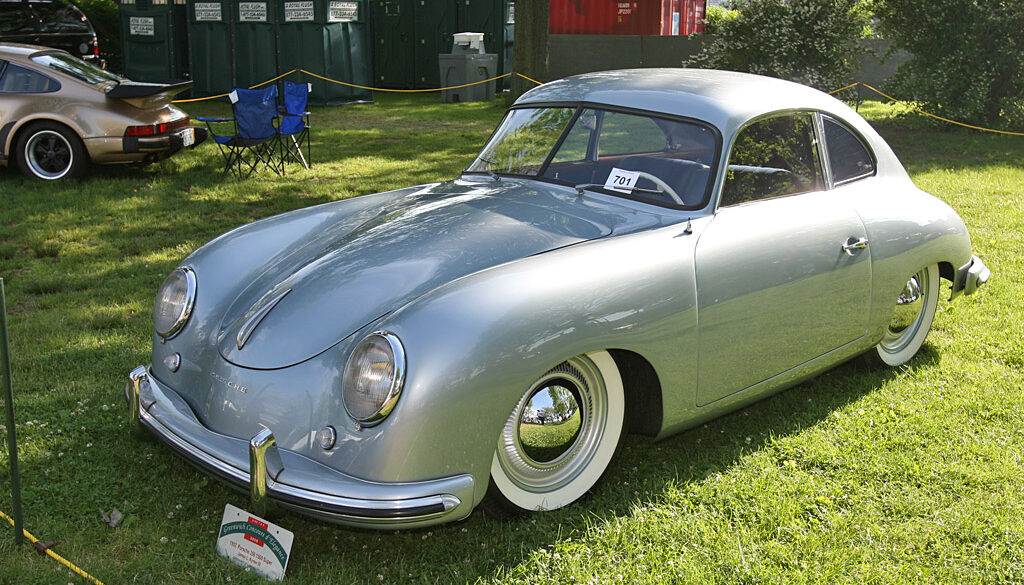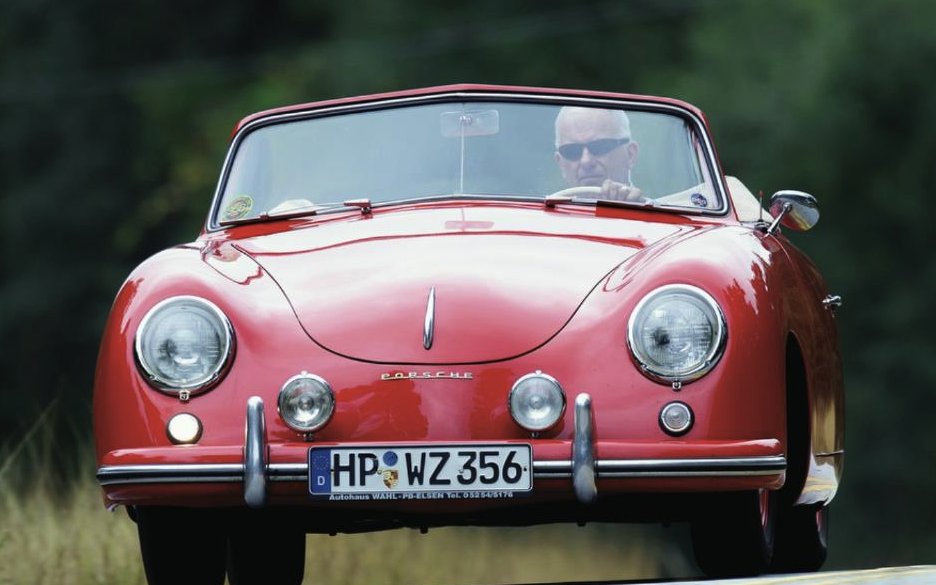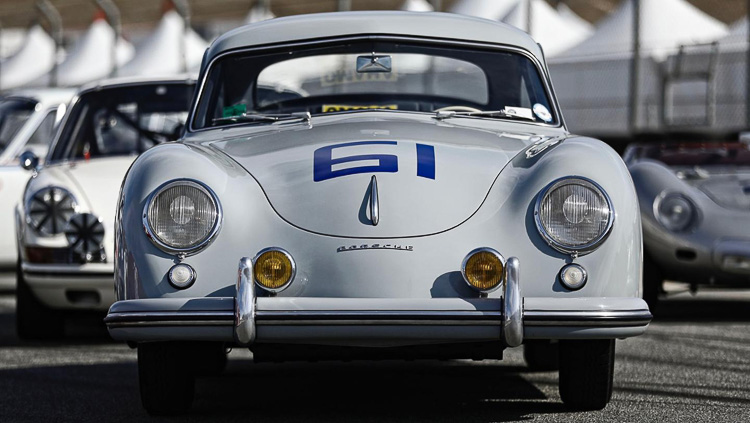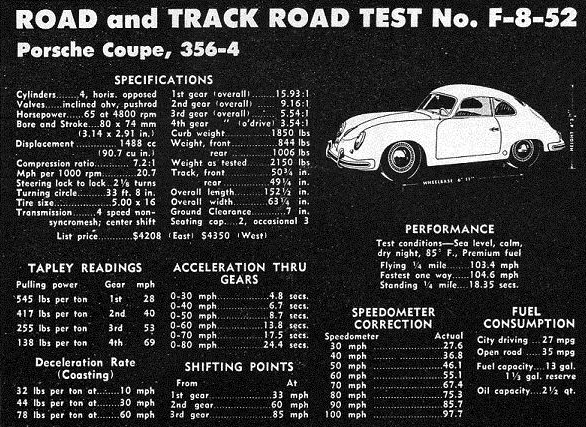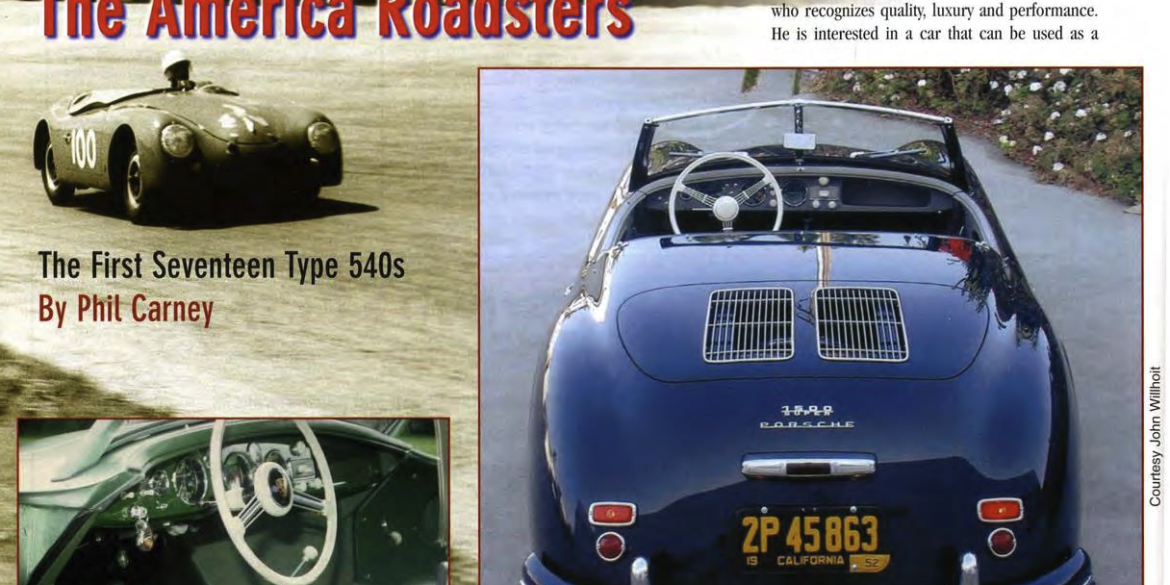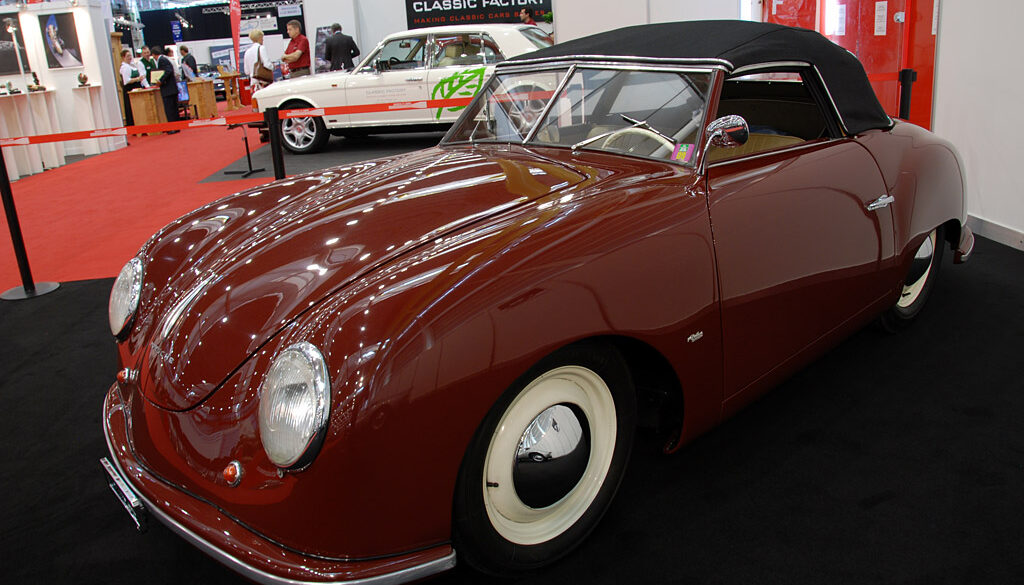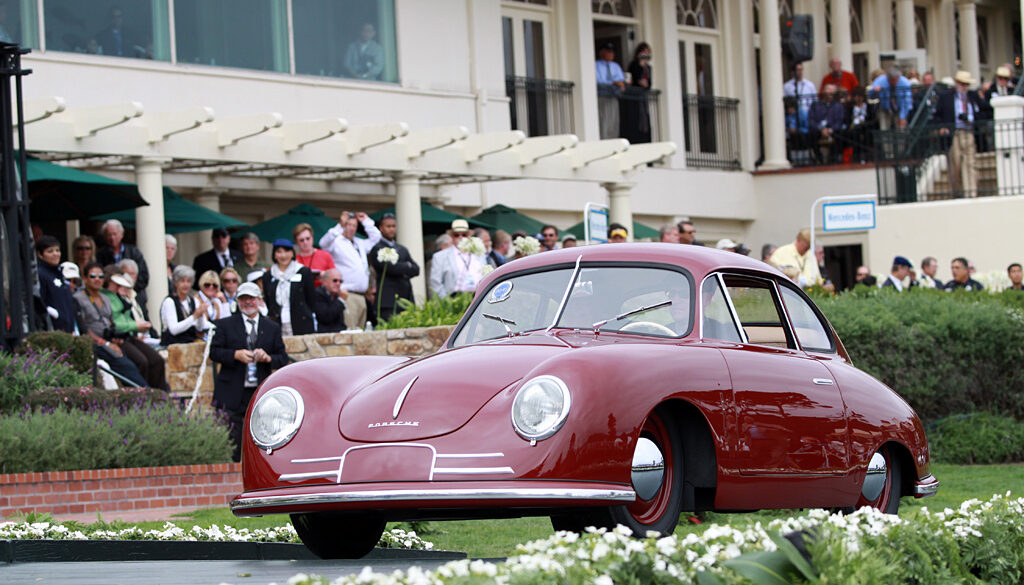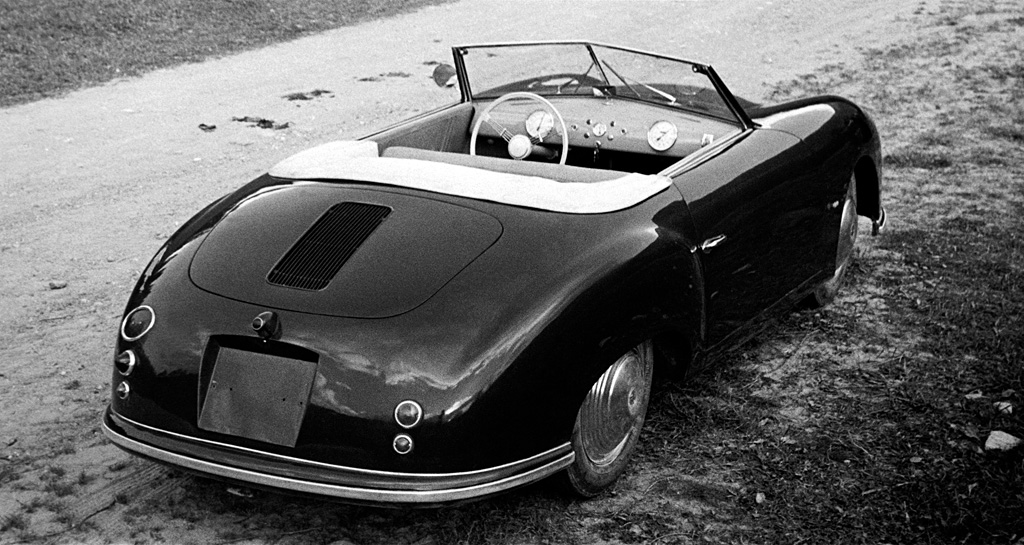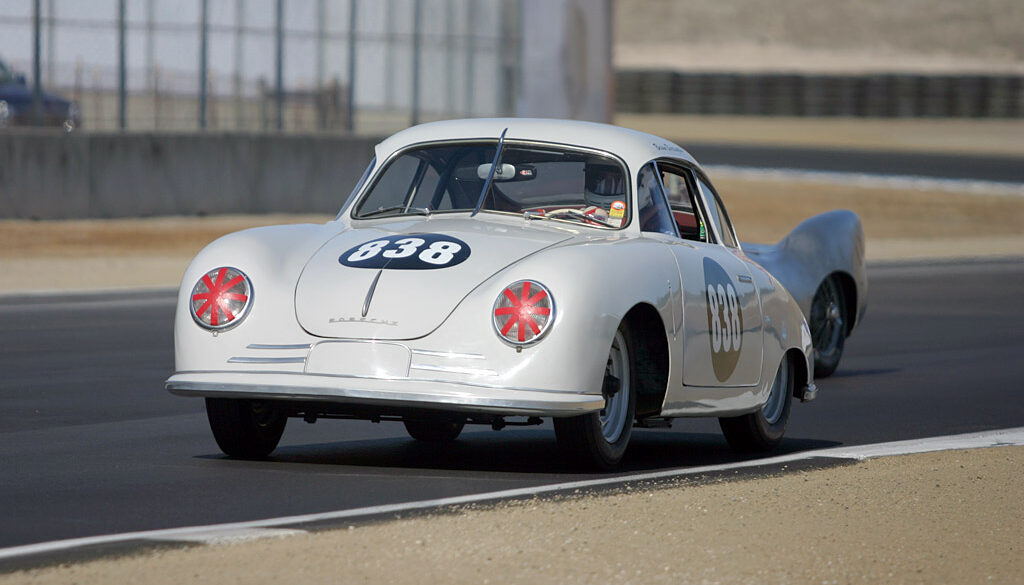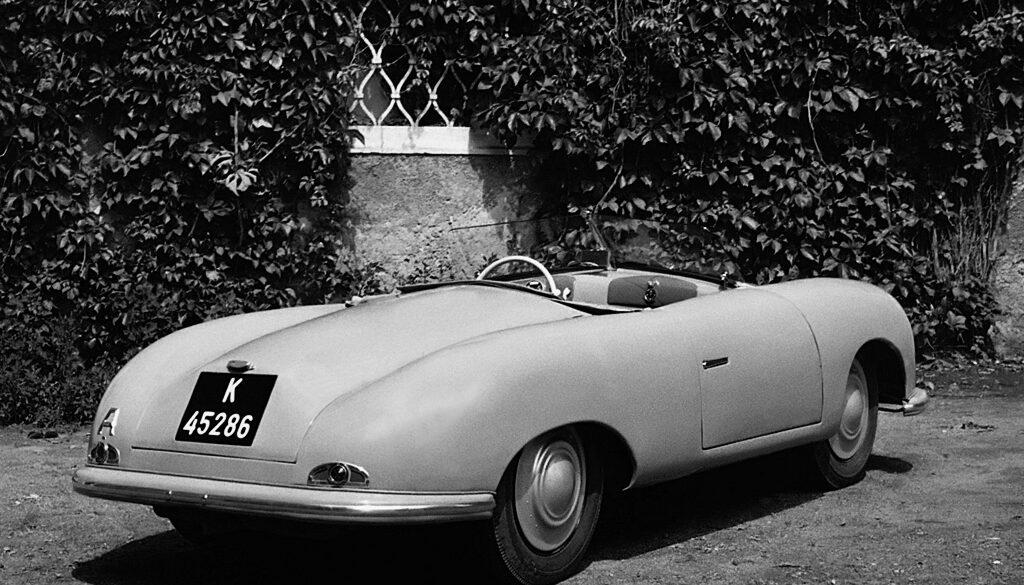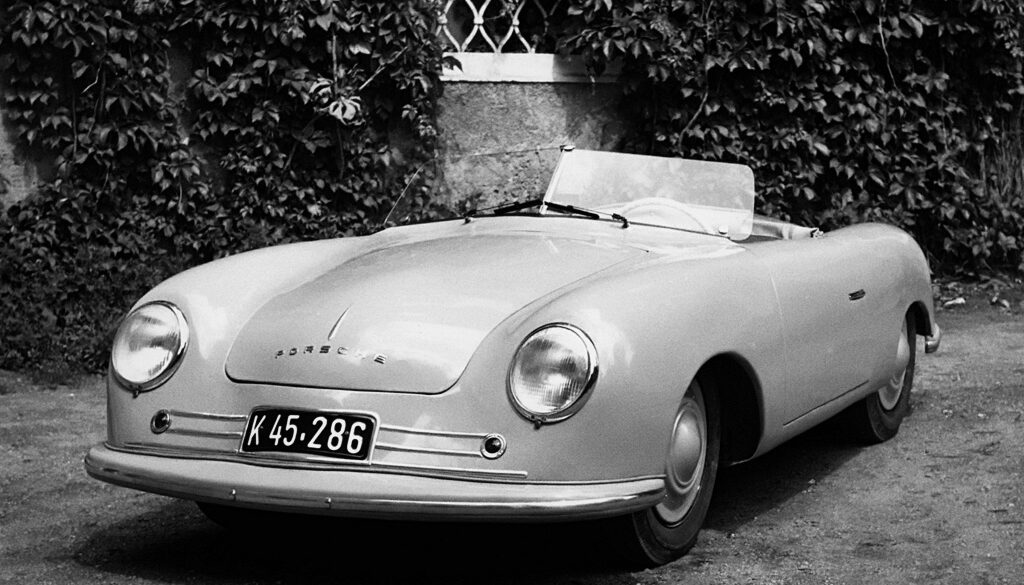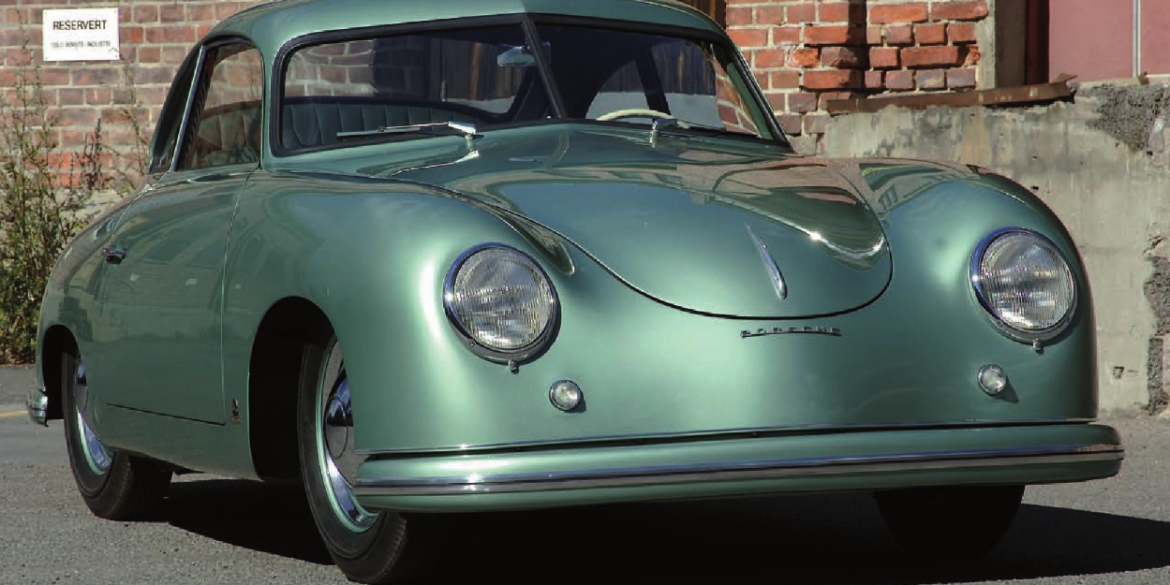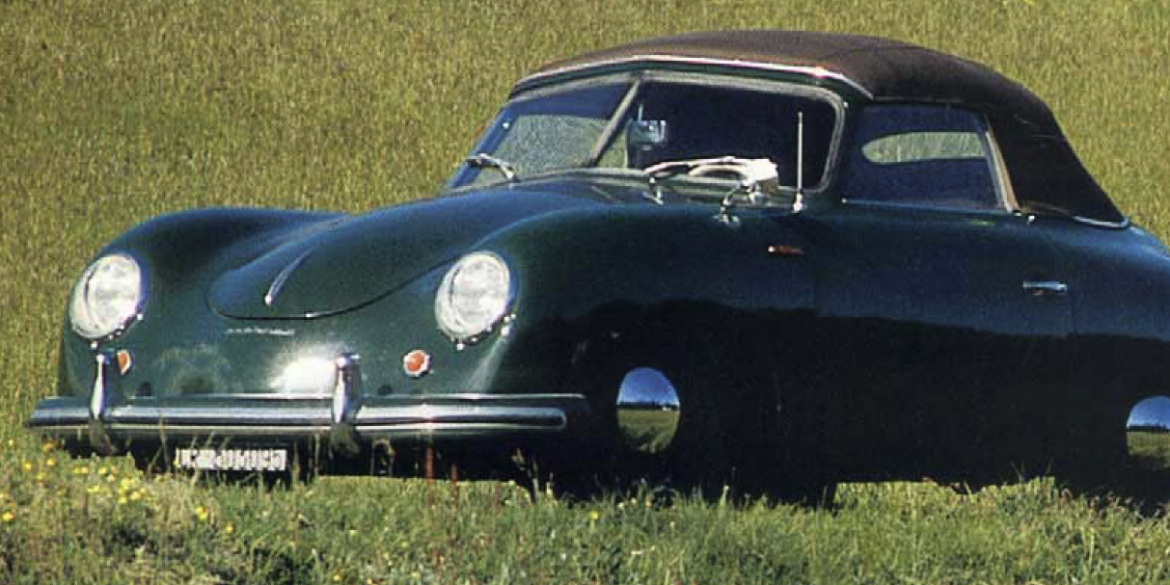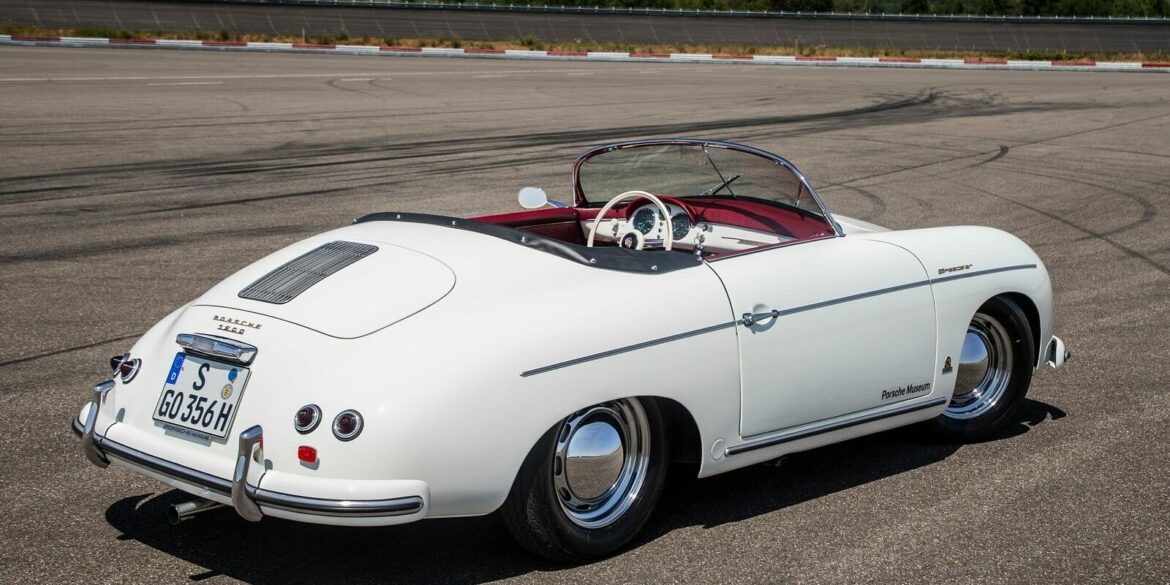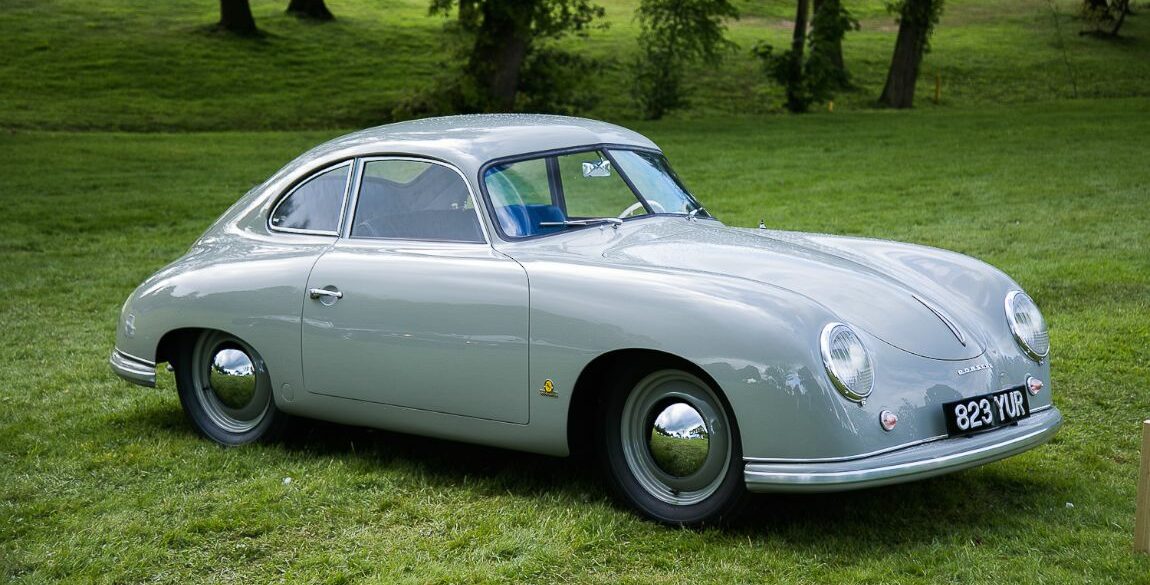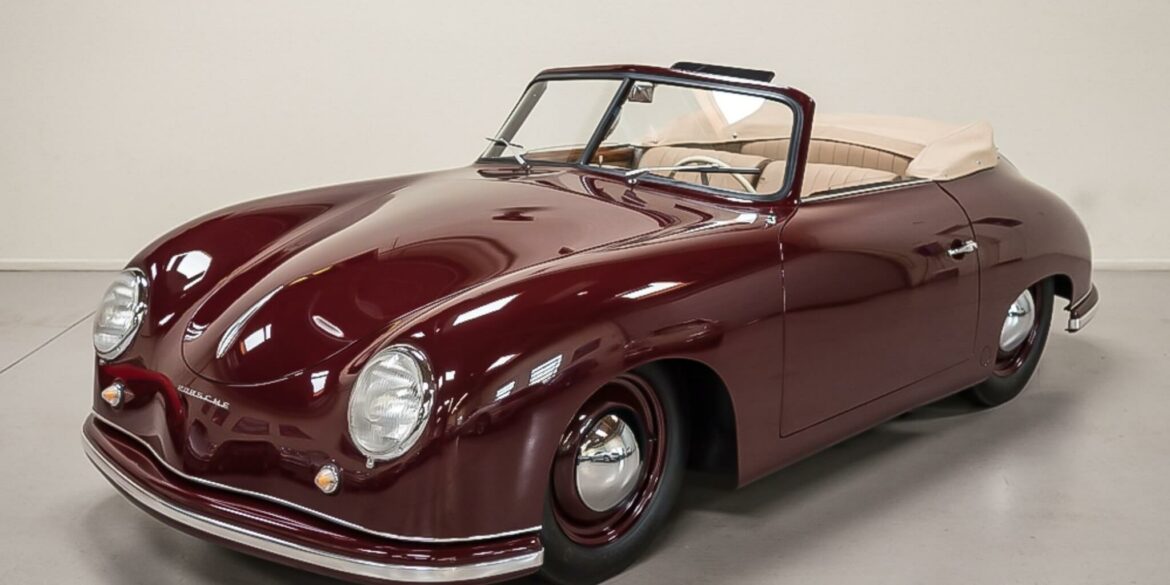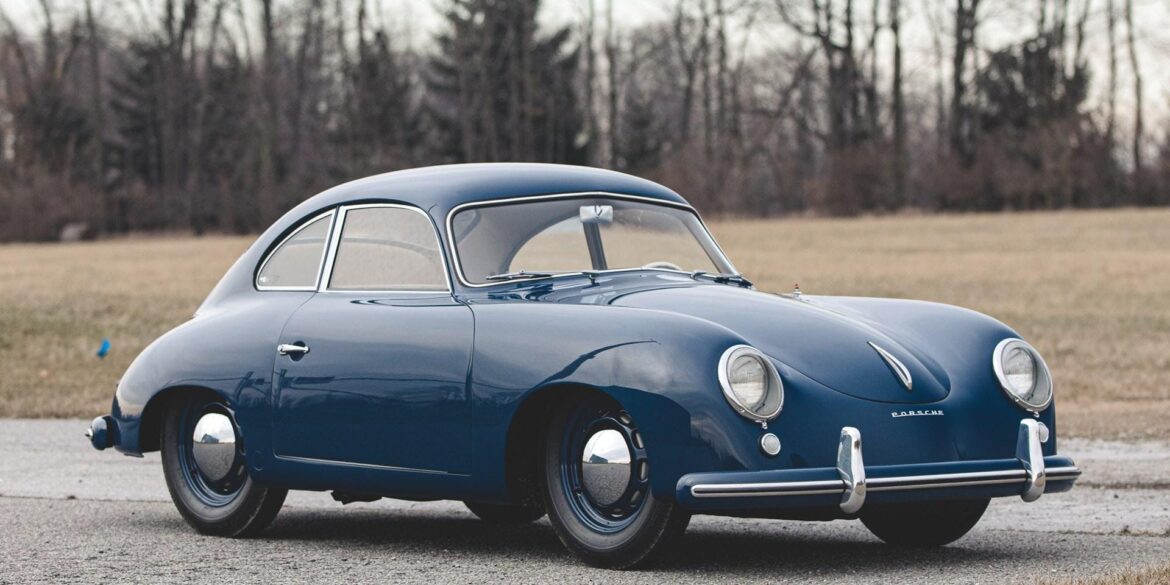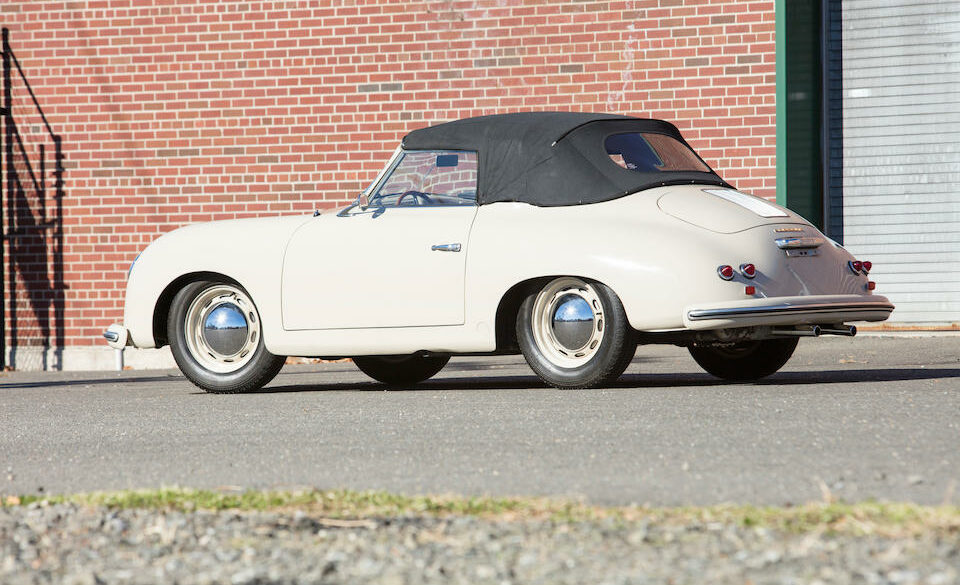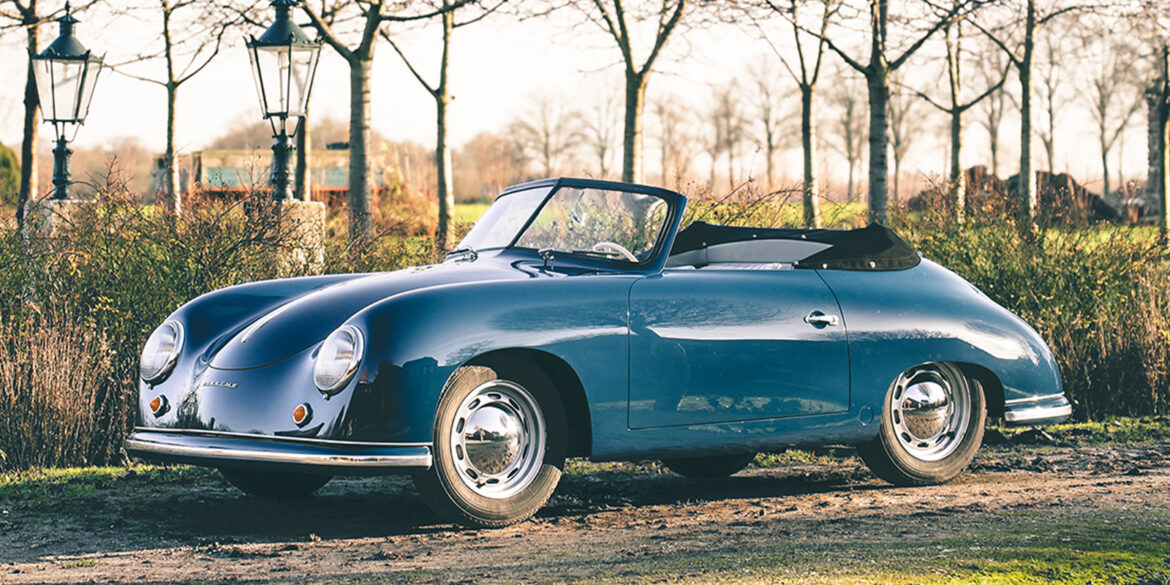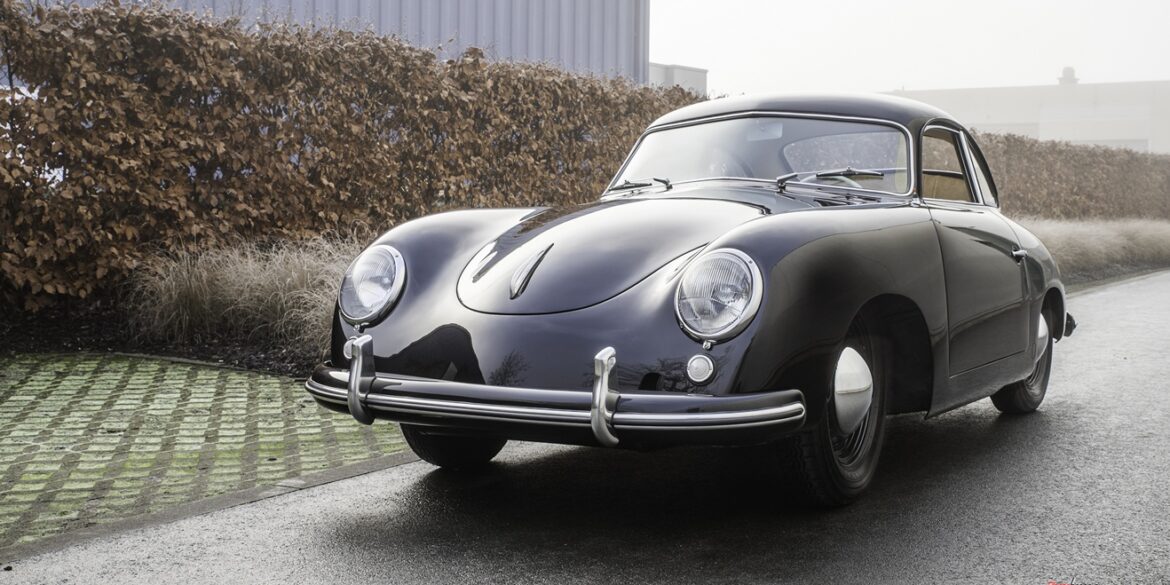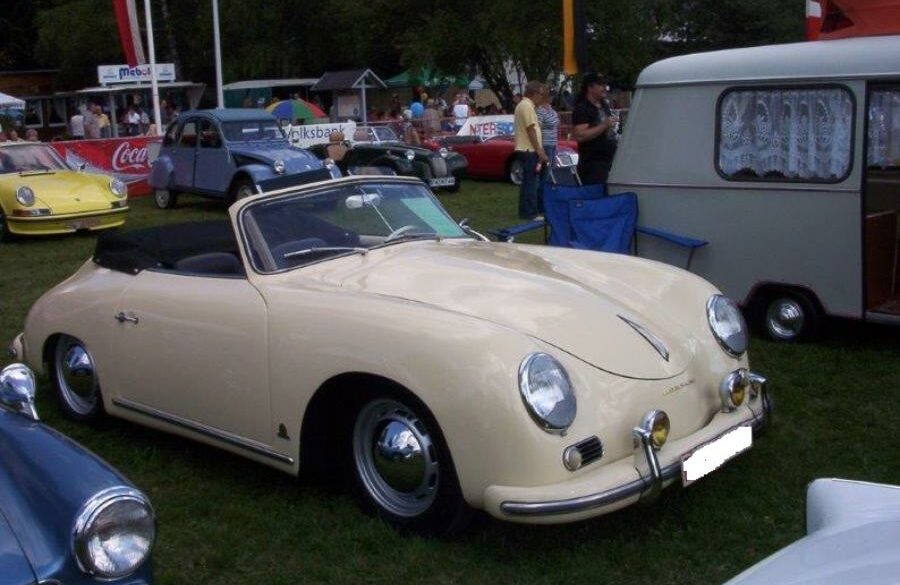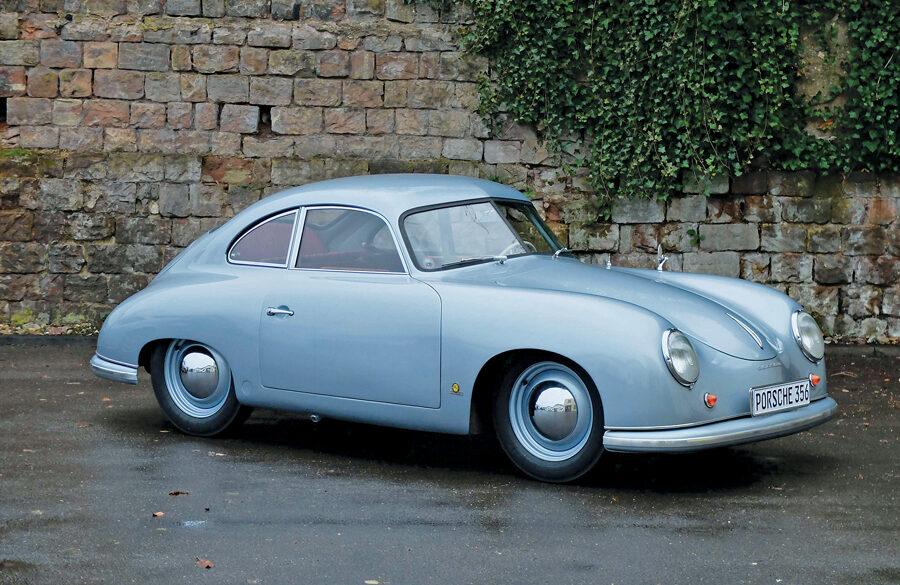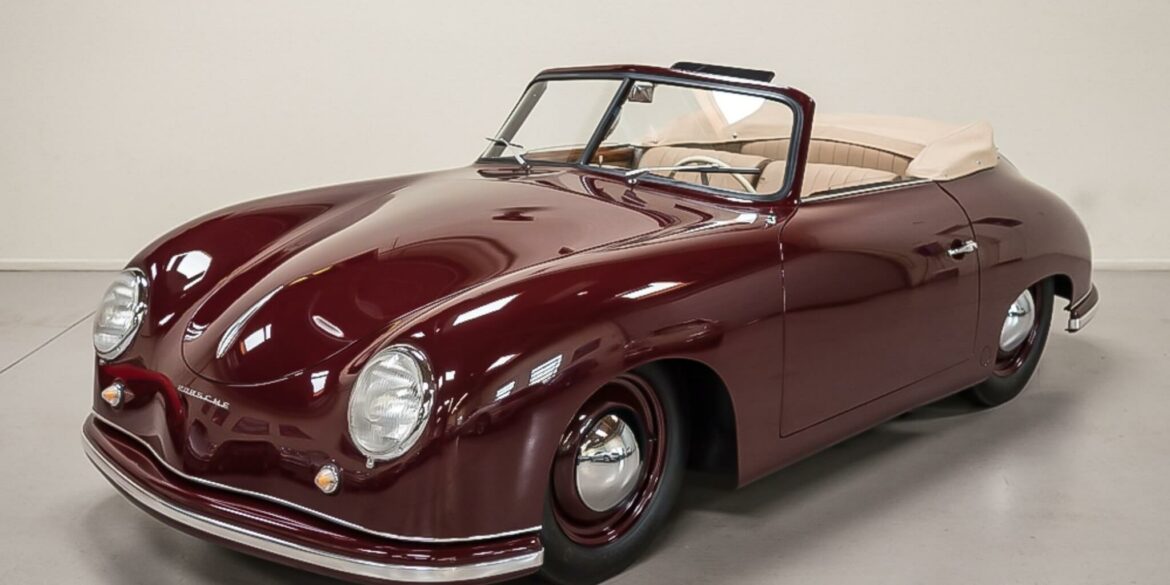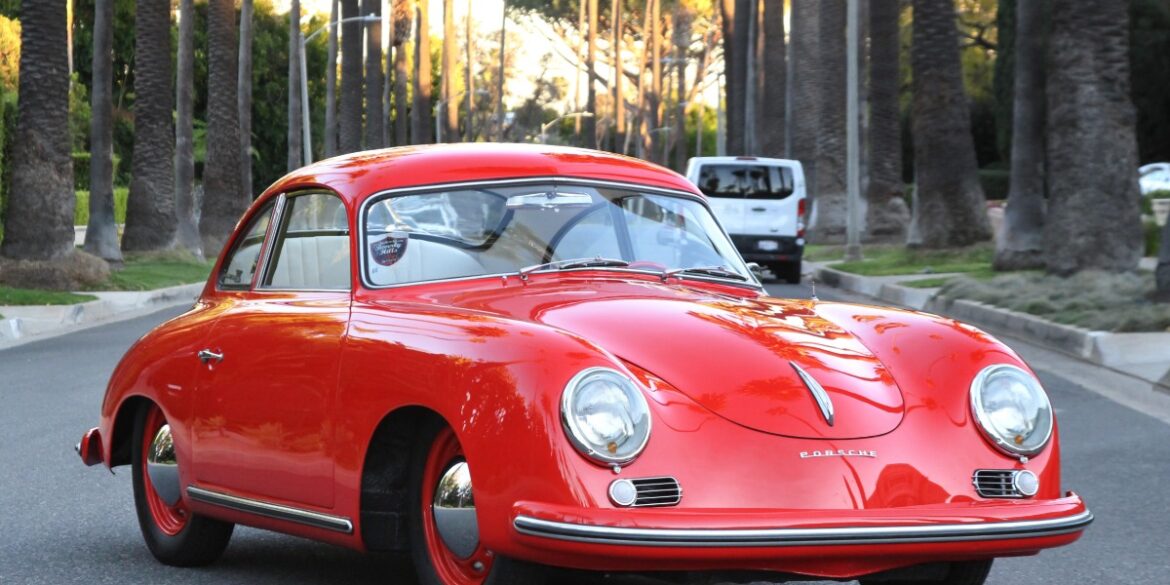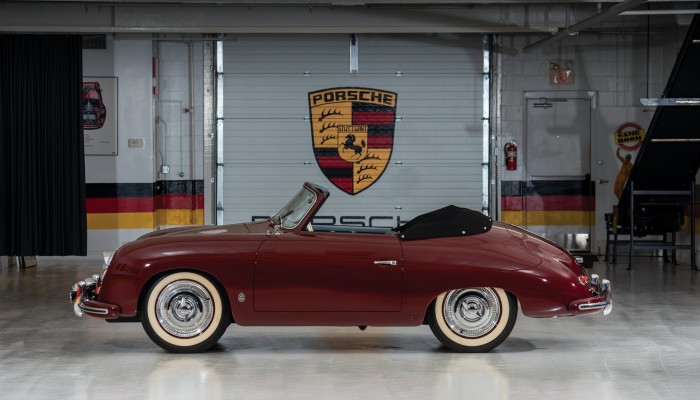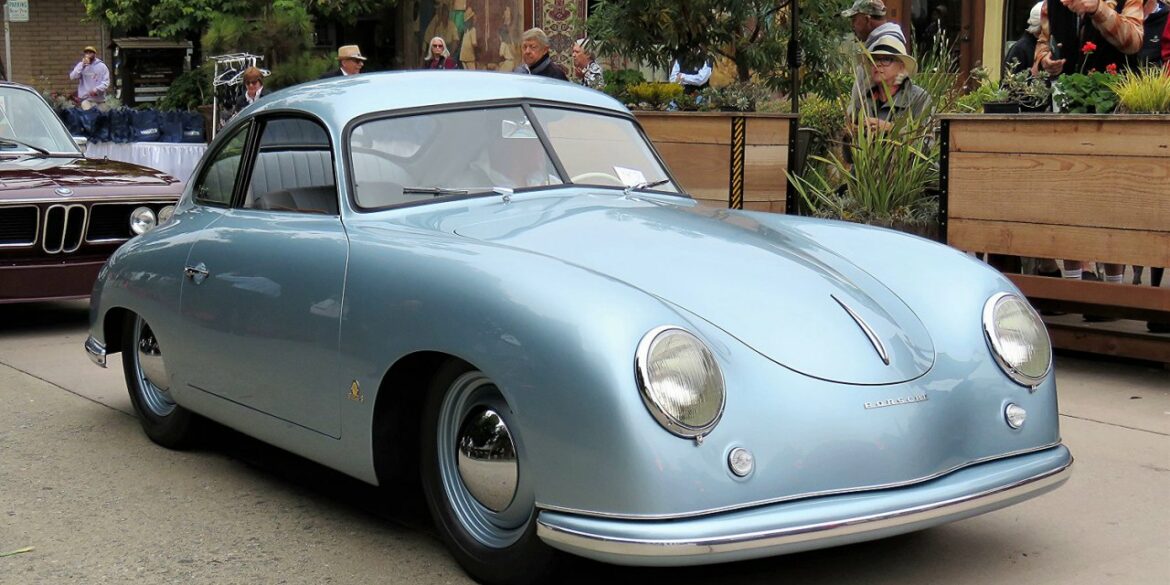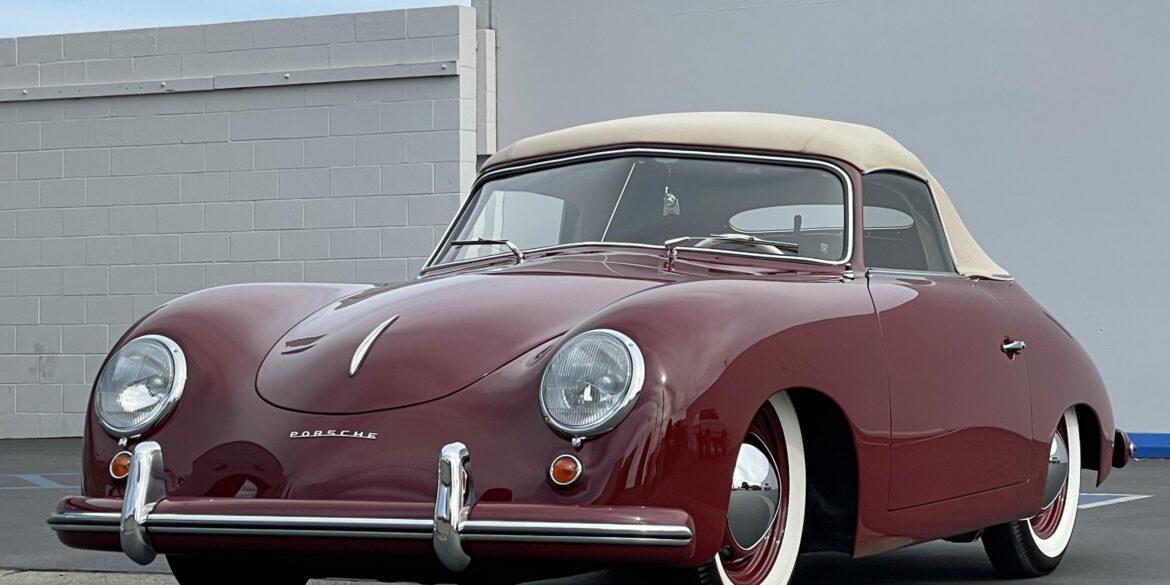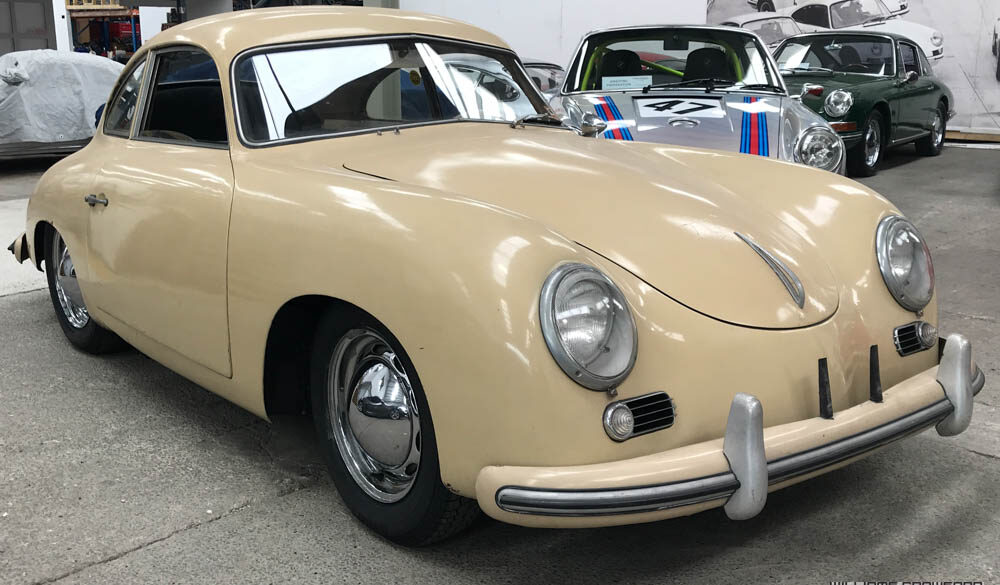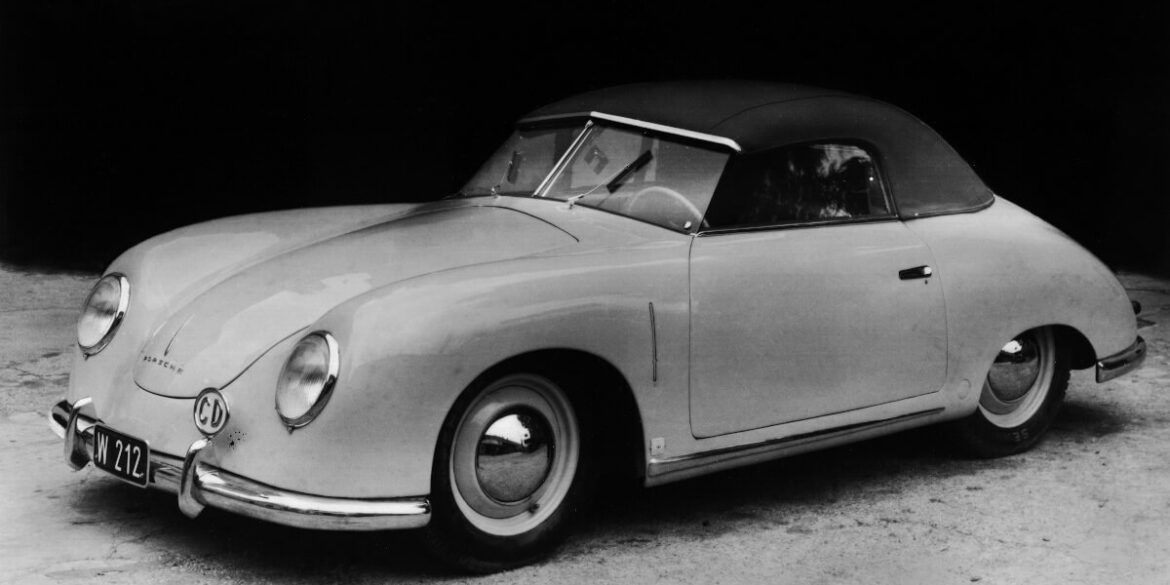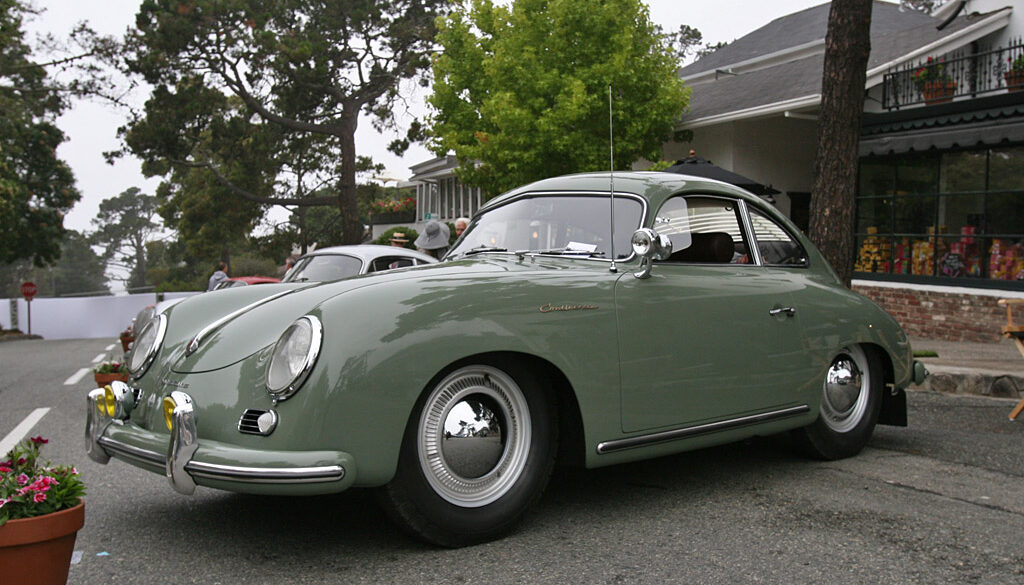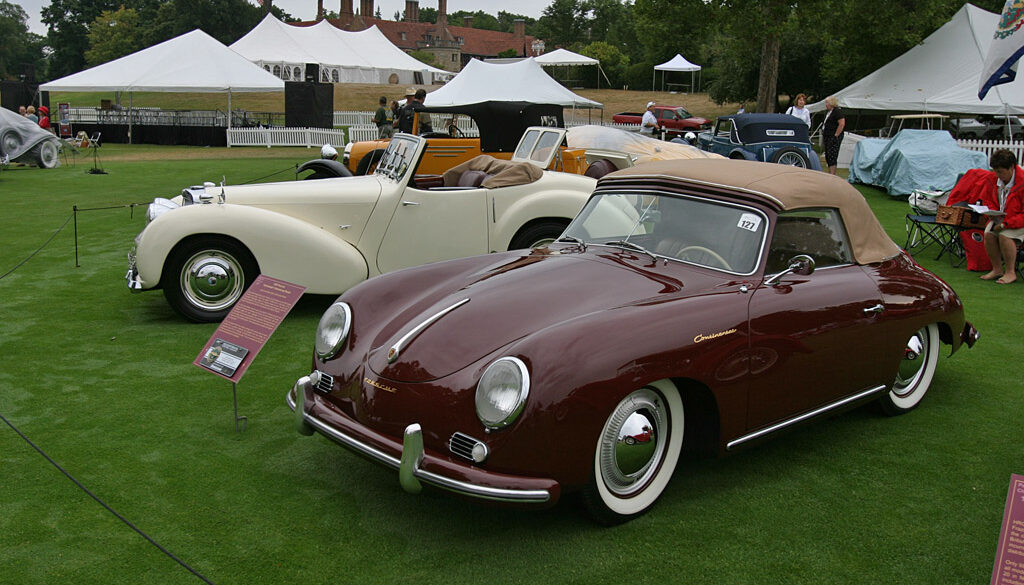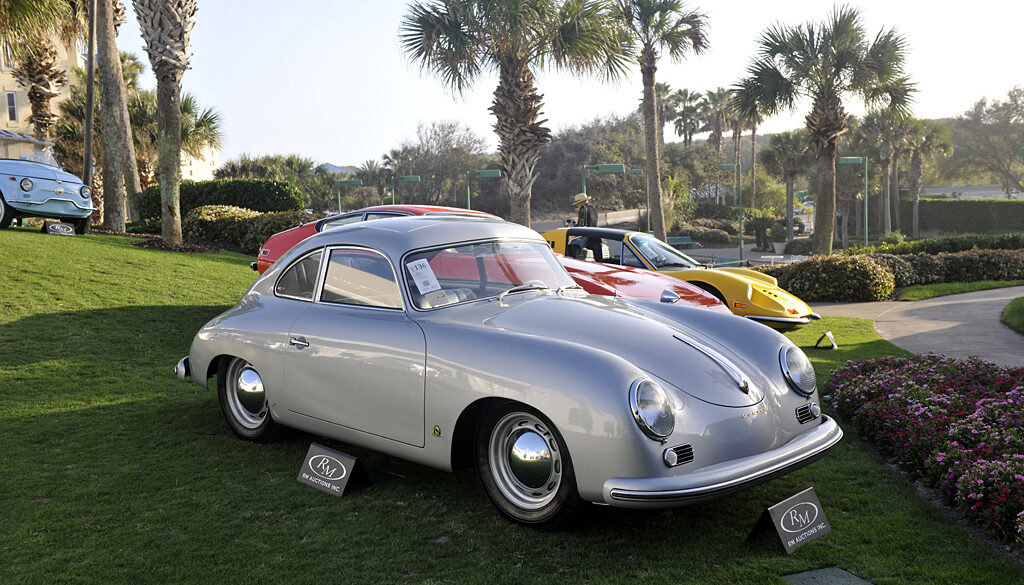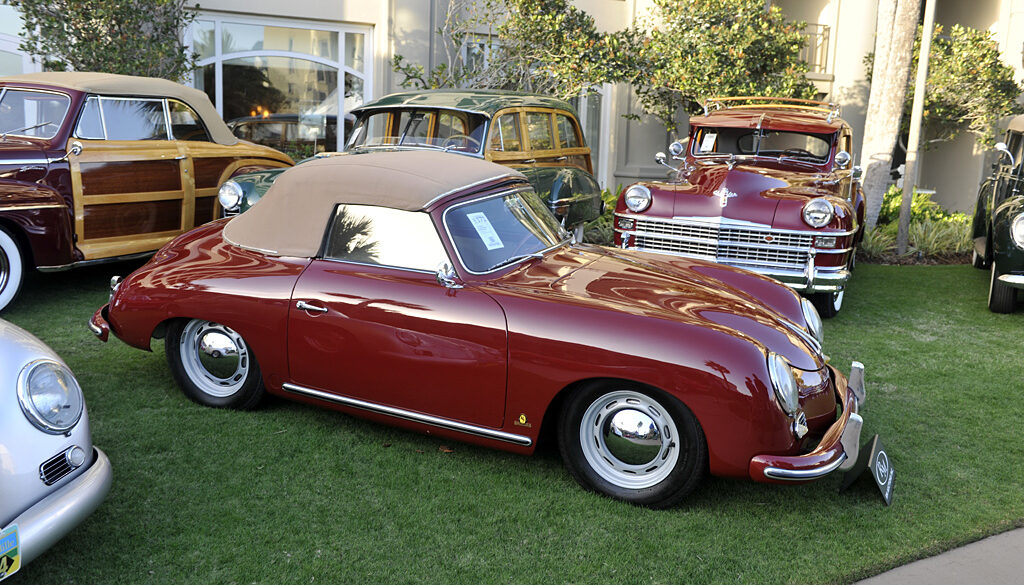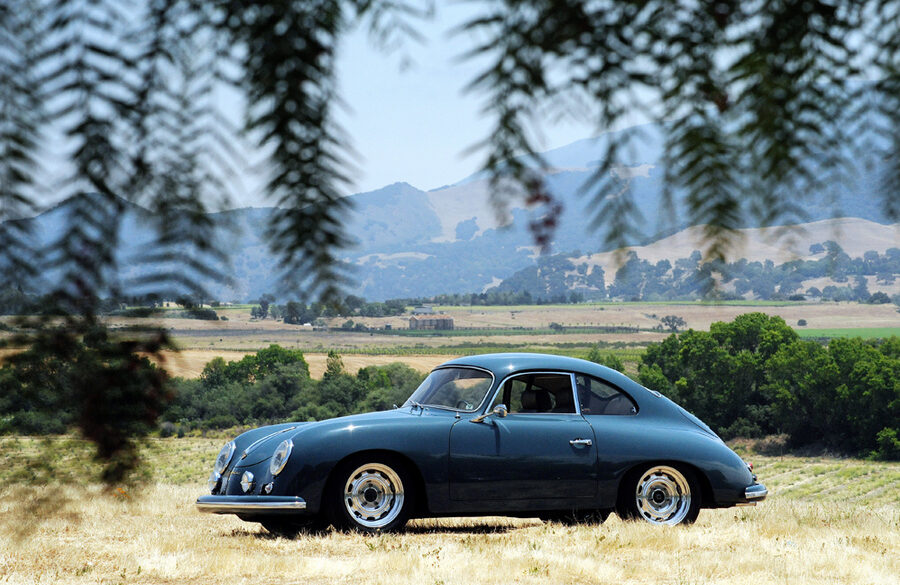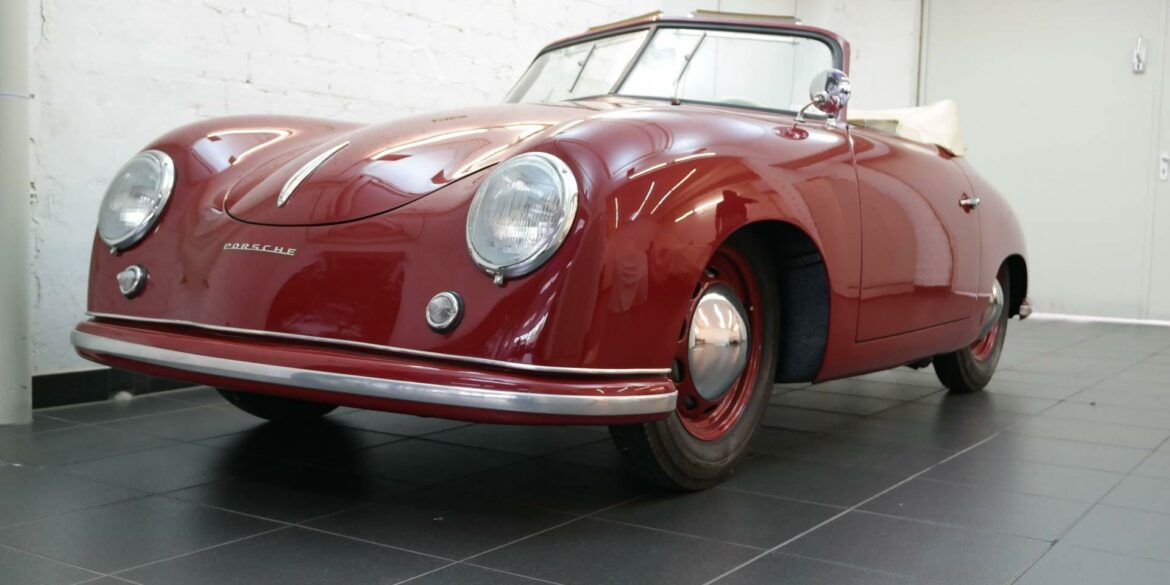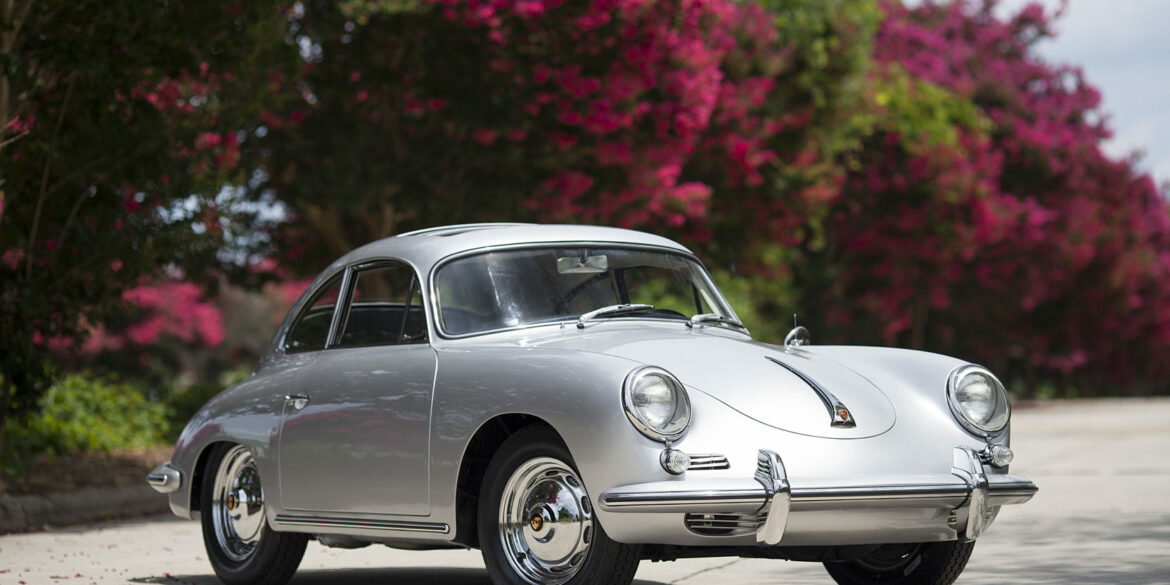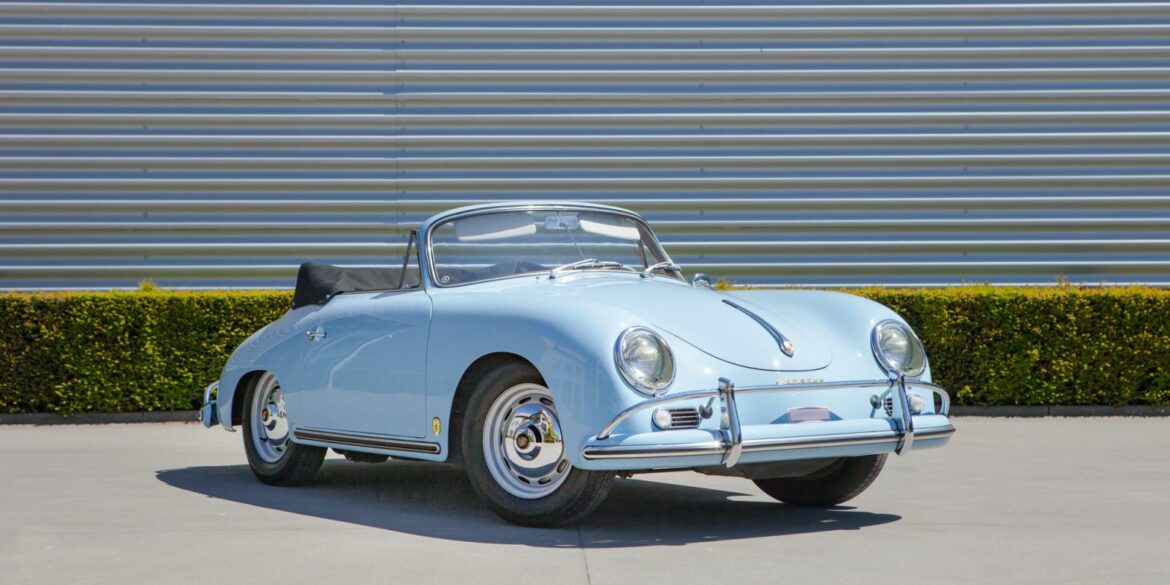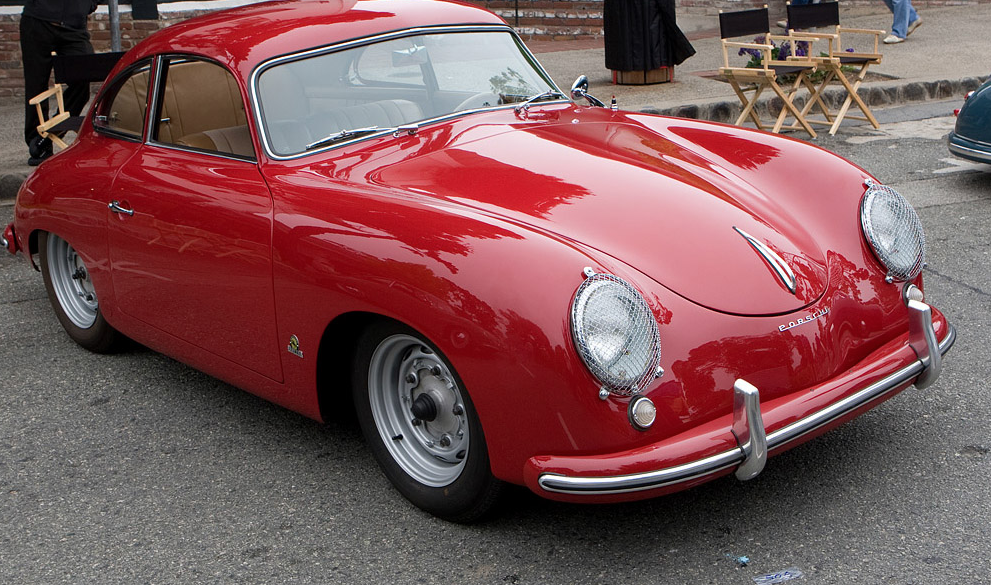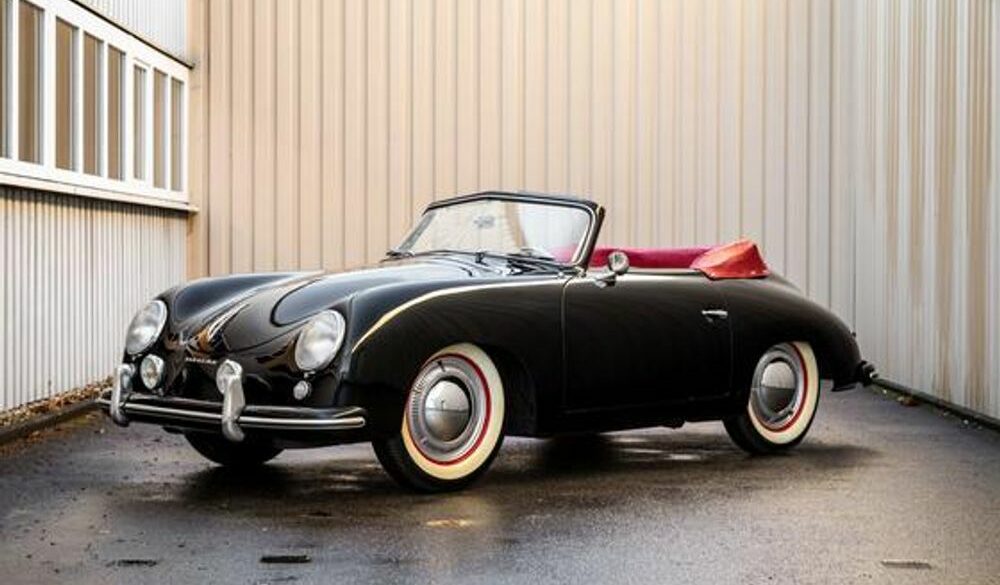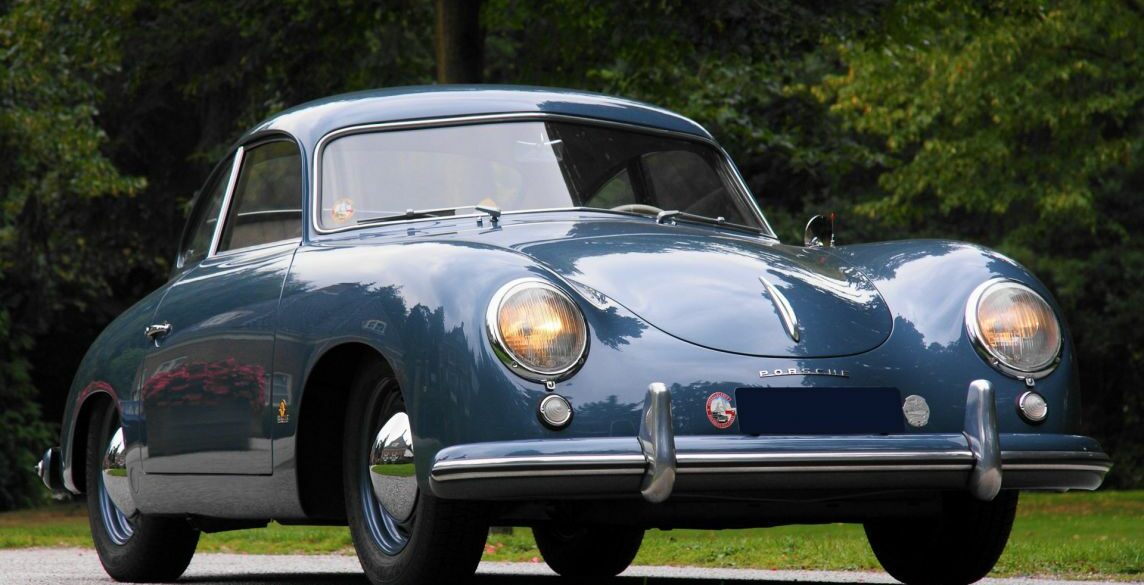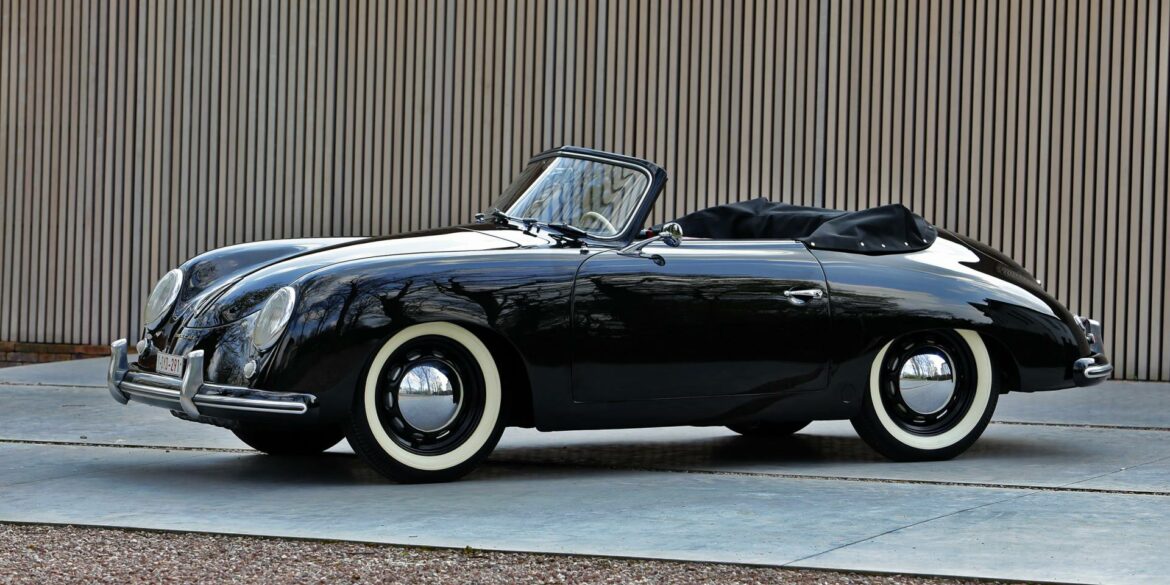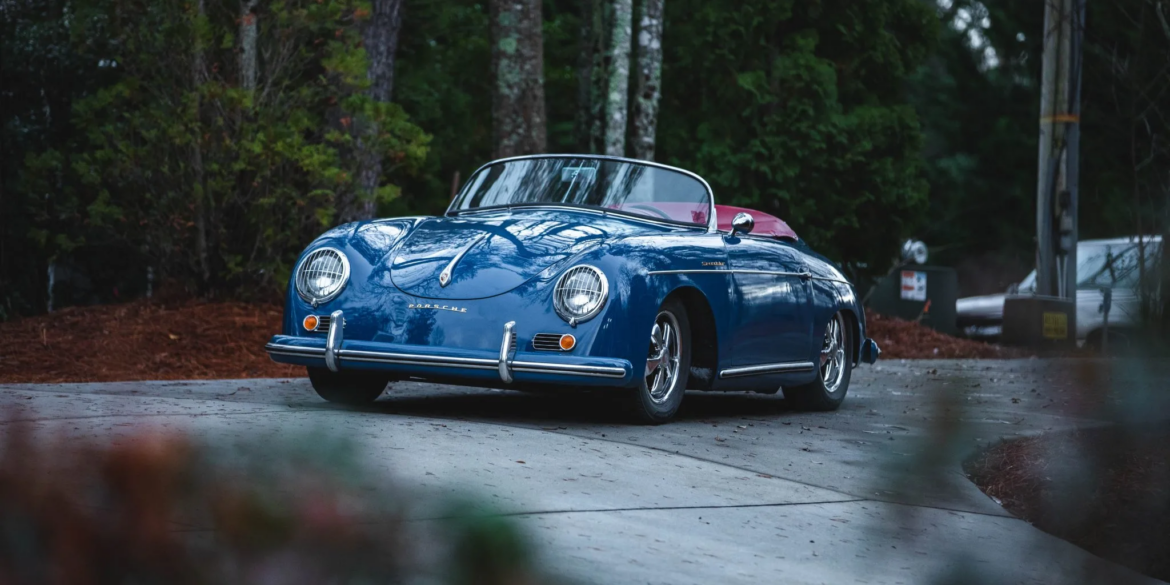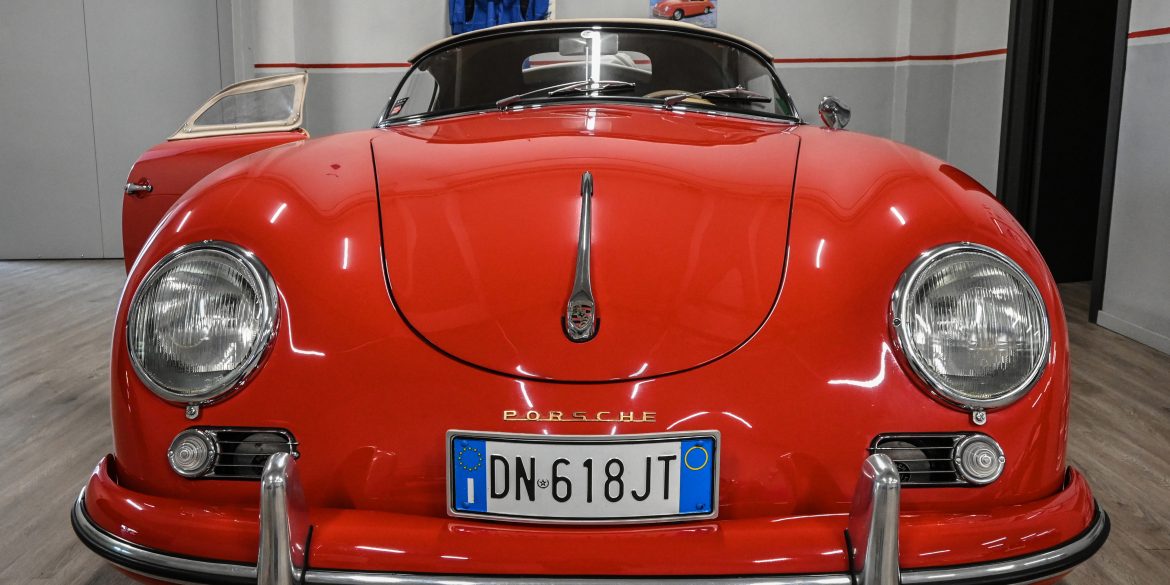When Porsche went to Le Mans, they reverted to aluminum shells made at their first factory in Gmünd, Austria. Three of these coupes, called 356 SL, raced Le Mans. All three Le Mans cars were shipped to America by Max Hoffman and sold to Fritz Kosler, Ed Trego and John von Neumann for SCCA racing. Before the 1952 races at Torrey Pines, von Neumann had Emil Diedt remove the coupe's roof, creating in effect the first Carrera Speedster.
In 1950, eleven remaining Gmund chassis were assembled after the factory returned to Germany and converted to SL (Sport Leicht) racing specification. They received 1,086-cc engines, enlarged fuel tanks, louvered quarter-window covers, wheel spats, streamlined aluminum belly fairings, and a pedestal-mounted shifter. Three Type 356/2 cars raced at Le Mans in 1951; two crashed, but 356/2-063 performed flawlessly, winning the 1,100-cc class.
Successful VW Dealer and racer Walter Glöckler built several specials for the German Car Championship including this roadster. It was built with assistance from Porsche in Zuffenhausen and raced without its optional hardtop in the 1952 champion before being shipped overseas for SCCA racing. Weidenhausen created the body from aluminum with a nose that bore close resemblance to the 356 Porsche but had semi-skirted rear wheels and cutaway rear corners similar to Glockler-Porsche 1 and 2.
The Porsche 356/1 was the first real car created by Ferdinand "Ferry" Porsche. This prototype car was a two-seater open roadster with a mid-mounted, air-cooled flat-4 engine of 1,131 cc displacement. While the body was an original design, most of the mechanicals were from the Volkswagen Beetle. Only one 356/1 was made.
With lessons learned from 356 No. 1, Porsche developed the 356/2 as a production-ready version. The biggest concession to useability was repositioning the engine back behind the rear wheels as the original VW design. Like 356 No. 1, 356/2 was built as two-seat roadster using VW parts.
Of the 52 cars made in Gmünd, only eight were built up as cabriolets. Each was outsourced for its body and interior construction. Six cars were sent to Beutler who constructed them with a slightly different shape than the factory coupes. Included was a kicked-up rear fender line which was used on several of the Buetler cabriolets.
The series production didn't allow the use of handmade aluminium body panels, so, the cars were made of stamped steel panels. The first Stuttgart-built 356 have later been called as 356 Pre-A. These cars have either two separate windscreen glasses like the 356 built in Austria, or a sharply bent windscreen glass! Introduced in 1948, the Porsche 356 Pre-A Coupe was the first variant available for the Porsche 356. The engine started as a 1100 cc flat four that produced 40 hp. It was available as a coupe and cabriolet body style.
The Porsche 356 Pre A Coupe and Cabriolet were introduced in 1950 and was available through mid-1955. Beginning in 1950 it was offered with a 1100 cc flat four that produced 40 hp. In 1951, a bigger 1.3-litre Type 506 engine was announced. It marked the first significant move away from the original Volkswagen unit. Bored from 73.5mm to 80mm (stroke was unchanged at 64mm), displacement rose from 1086cc to 1286cc. Further enhancements included lightweight alloy cylinder barrels and nosed pistons. Output rose from 40 bhp to 44 bhp and torque increased from 51 lb-ft to 60 lb-ft.
The 1500 was Porsche’s newest engine which was quickly fitted with 40 PIBC Solex carburetors to produce 60 bhp @ 5000 rpm in 1952. These retained the Hirth roller-bearing crankshafts which gave Porsche enough clearance to enlarge their engine to 1500cc. Most cars from 1952 until the 356A of 1956 were powered by the 1500 engine but some left the factory with the smaller 1.1 and 1.3-liter engines. At the request of American importer Max Hoffman, 356s for the 1955 model year were badged as Continentals before reaching the U.S
Towards the end of 1951 Porsche introduced a larger version of the flat four engine. It was offered alongside the original 1.1 litre engine. It took a lot more effort to develop the third variation on the four cylinder theme; the '1500.' Introduced in the 356 1500 during 1952, the engine produced 55 bhp. Porsche's competition department reworked the 1500 engine with hotter cams and bigger Carburetors, boosting power to 70 bhp. In 1952 this engine found its way into a new road car; the 356 Super.
In 1953, the 1300 S or "Super" was introduced, and the 1,100 cc engine was dropped. The 360 1300 Super boasts a power improvement to 60 BHP with Porsche's "Super" engine in the Porsche 356 model range. Minor visual differences were implemented such as front indicators integrated with the horn grilles and bumpers protrude from the body with over-riders. In June 1954, the plain-bearing 1300cc engine switched over to the same block as the 4cc larger roller-bearing variant.
An export hit, built in response to customer demand: the American importer Max Hoffman requested a Porsche costing less than 3,000 dollars for his market. The 356 Speedster was the answer, naturally with a spartan equipment specification. But the lightweight car was a big hit in the USA. It was used mainly for motor racing and soon became a regular feature of the motor sport scene.
Generally speaking the early models or so called ‘Pre A 356′ models are more desirable than the later models. At the top of the pyramid and the most exclusive is the Carrera version which carries the legendary 4 cam ‘Fuhrman’ engine. But just below that comes the ‘Super’ speedster. The ‘super’ version had more horsepower (75 vs the standard 60) and the powerful ‘type 528 engine’ for the 1500 Super version.
Beginning in 1954, a new version of the Pre A 356 was introduced that is now known as the Porsche 356 Pre-A Carrera, with a powerful engine that was available in coupe, cabriolet, and Speedster variants. Highly desirable today, the Carrera name denotes the race inspired 1500 cc four cam motor that produced an astounding 110 hp. Approximately 97 of these motors were produced sometime between 1954 and early 1955. The Carrera versions would continue in the next generation 356 as the Porsche 356 A Carrera.
This isn't technically a Speedster, but the Type 540 (Typ 540 K/9-1 to be very precise) - known more commonly as the America Roadster - started the idea. The American Roadster was the direct predecessor of the Speedster. U.S. importer Max Hoffman convinced Porsche it needed a lightweight convertible to compete. It only had an emergency folding roof and could keep up with larger sports cars of the era. But the production methods used to create the America Roadster’s aluminum body proved to be too expensive, and in 1952 Porsche built only 21 units before its discontinuation in 1953.
1952 Porsche 356 ‘America Roadster’ Pictures & Gallery...
1955 Porsche 356/1500 Continental Cabriolet Pictures & Gallery...
1955 Porsche 356/1500 Continental Coupe Pictures & Gallery...
1954 – 1955 Porsche 356/1500 Speedster Pictures & Gallery...
1952 – 1955 Porsche 356/1500 Cabriolet (Pre-A) Pictures & Gallery...
1952 – 1955 Porsche 356/1500 Coupe (Pre-A) Pictures & Gallery...
1950 – 1951 Porsche 356/1100 Split-Window Coupe (Pre-A) Pictures & Gallery...
Kim Copperthite watches the Porsche 919 Hybrid Evo during its record run at the Porsche Rennsport Reunion VI, Laguna Seca, 2018 (© Mike Copperthite) It is interesting how, sometimes when you trace an old classic car or historic racer back to its roots, you end up not far from the...
Porsche 356/2 Gmünd Cabriolet Specifications type Series Production Car production years 1948 – 1951 built at Austria production 41 price $ $ 3,750 engine Type 369 Flat-4 position Rear, Longitudinal valvetrain Pushrod OHV fuel feed Dual Solex 26 VFJ Downdraft displacement 1086 cc / 66.27 in³ compression 6.5:1 power 29.8...
No Subscription? You’re missing out Get immediate ad-free access to all our premium content. Get Started Already a Member? Sign in to your account here....
Porsche 356/2 Gmünd Cabriolet Pictures Of the 50 cars made in Gmünd, only eight were built up as cabriolets. Each was outsourced for its body and interior construction with six going to Beutler who constructed them with a slightly different shape than the factory coupes. Included was a kicked-up rear...
Porsche 356/2 Gmünd Coupé Pictures The rare 356/2 aluminum bodied Porsche Gmünd Coupes are some of the most stunning Porsche case ever made. There was a total production of 52 units built in Gmund, with an additional 11 bodies created later for competition cars....
No Subscription? You’re missing out Get immediate ad-free access to all our premium content. Get Started Already a Member? Sign in to your account here....
Porsche 356/1 Pictures Today we call the first mid-engined Porsche roadster as 356/1 (or 356 no. 1) to distinguish it from the rear-engined Porsches that followed. Below we have an assortment of photos we curated of the first prototype cars....
No Subscription? You’re missing out Get immediate ad-free access to all our premium content. Get Started Already a Member? Sign in to your account here....
No Subscription? You’re missing out Get immediate ad-free access to all our premium content. Get Started Already a Member? Sign in to your account here....
No Subscription? You’re missing out Get immediate ad-free access to all our premium content. Get Started Already a Member? Sign in to your account here....
No Subscription? You’re missing out Get immediate ad-free access to all our premium content. Get Started Already a Member? Sign in to your account here....
No Subscription? You’re missing out Get immediate ad-free access to all our premium content. Get Started Already a Member? Sign in to your account here....
1950 – 1951 Porsche 356/1100 Split-Window Cabriolet (Pre-A) Pictures & Gallery...
1952 – 1954 Porsche 356/1100 Coupe (Pre-A) Pictures & Gallery...
1952 – 1954 Porsche 356/1100 Cabriolet (Pre-A) Pictures & Gallery...
No Subscription? You’re missing out Get immediate ad-free access to all our premium content. Get Started Already a Member? Sign in to your account here....
No Subscription? You’re missing out Get immediate ad-free access to all our premium content. Get Started Already a Member? Sign in to your account here....
No Subscription? You’re missing out Get immediate ad-free access to all our premium content. Get Started Already a Member? Sign in to your account here....
No Subscription? You’re missing out Get immediate ad-free access to all our premium content. Get Started Already a Member? Sign in to your account here....
1951 – 1953 Porsche 356/1300 Split-Window Coupe (Pre-A) Pictures & Gallery...
1951 – 1953 Porsche 356/1300 Split-Window Cabriolet (Pre-A) Pictures & Gallery...
1954 – 1955 Porsche 356/1300 Split-Window Coupe (Pre-A) Pictures & Gallery...
1954 – 1955 Porsche 356/1300 Split-Window Cabriolet (Pre-A) Pictures & Gallery...
No Subscription? You’re missing out Get immediate ad-free access to all our premium content. Get Started Already a Member? Sign in to your account here....
No Subscription? You’re missing out Get immediate ad-free access to all our premium content. Get Started Already a Member? Sign in to your account here....
No Subscription? You’re missing out Get immediate ad-free access to all our premium content. Get Started Already a Member? Sign in to your account here....
No Subscription? You’re missing out Get immediate ad-free access to all our premium content. Get Started Already a Member? Sign in to your account here....
1954 – 1955 Porsche 356/1300 Super Coupe (Pre-A) Pictures & Gallery...
1954 – 1955 Porsche 356/1300 Super Cabriolet (Pre-A) Pictures & Gallery ...
No Subscription? You’re missing out Get immediate ad-free access to all our premium content. Get Started Already a Member? Sign in to your account here....
No Subscription? You’re missing out Get immediate ad-free access to all our premium content. Get Started Already a Member? Sign in to your account here....
No Subscription? You’re missing out Get immediate ad-free access to all our premium content. Get Started Already a Member? Sign in to your account here....
No Subscription? You’re missing out Get immediate ad-free access to all our premium content. Get Started Already a Member? Sign in to your account here....
1953 – 1955 Porsche 356/1500 Super Coupe (Pre-A) Pictures & Gallery ...
1953 – 1955 Porsche 356/1500 Super Cabriolet (Pre-A) Pictures & Gallery...
Live now on Bring A Trailer is fantastic example of a 1955 Porsche 356 Speedster finished in Oslo Blue over red upholstery and powered by a Type 546 1.5-liter flat-four engine. In September 1954, Porsche launched a new model which was to become a legend – the Speedster. The new...
This immaculate auto is in the collection of Brescia Classic Cars in Italy. It’s #48 of only 200 similar cars built by Porsche in 1954. Part of the “Pre-A” production of Porsche 356 cars produced from 1948 to 1955, the first Speedster powerplants were 1100 cc, increased to 1500 cc...


